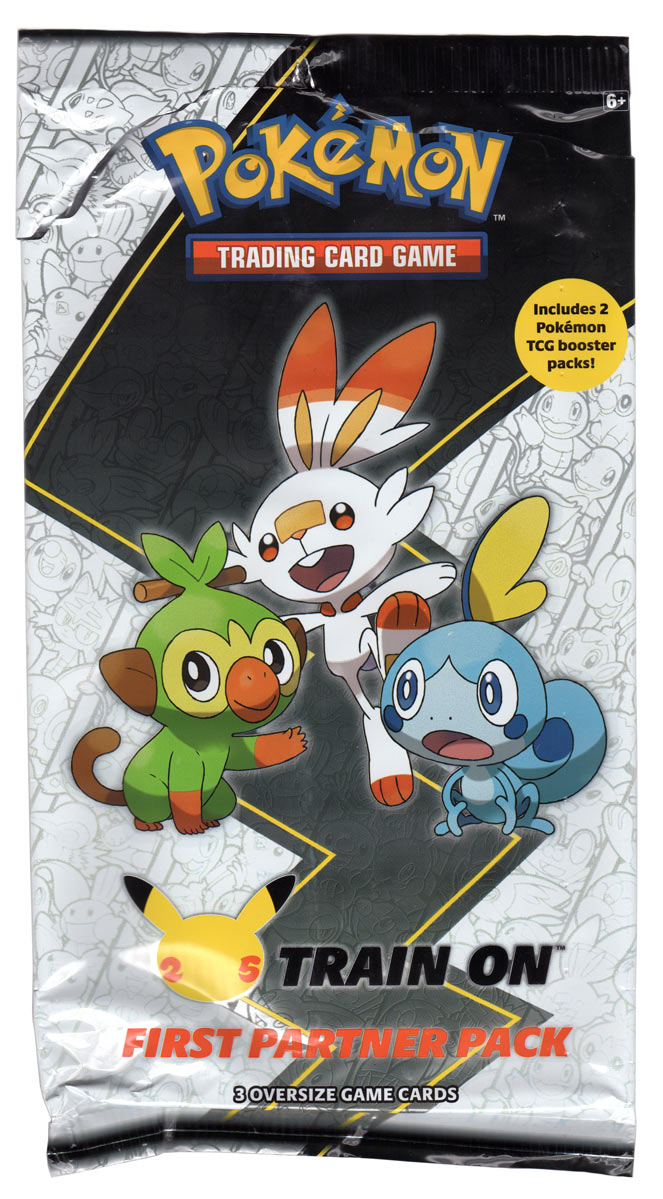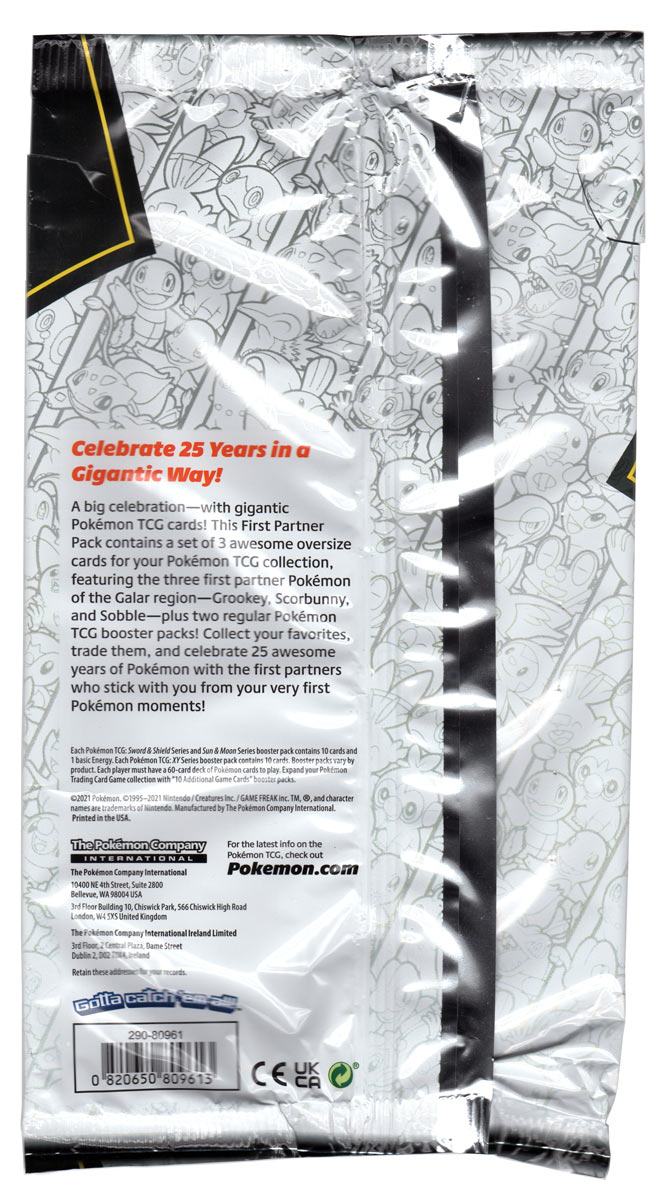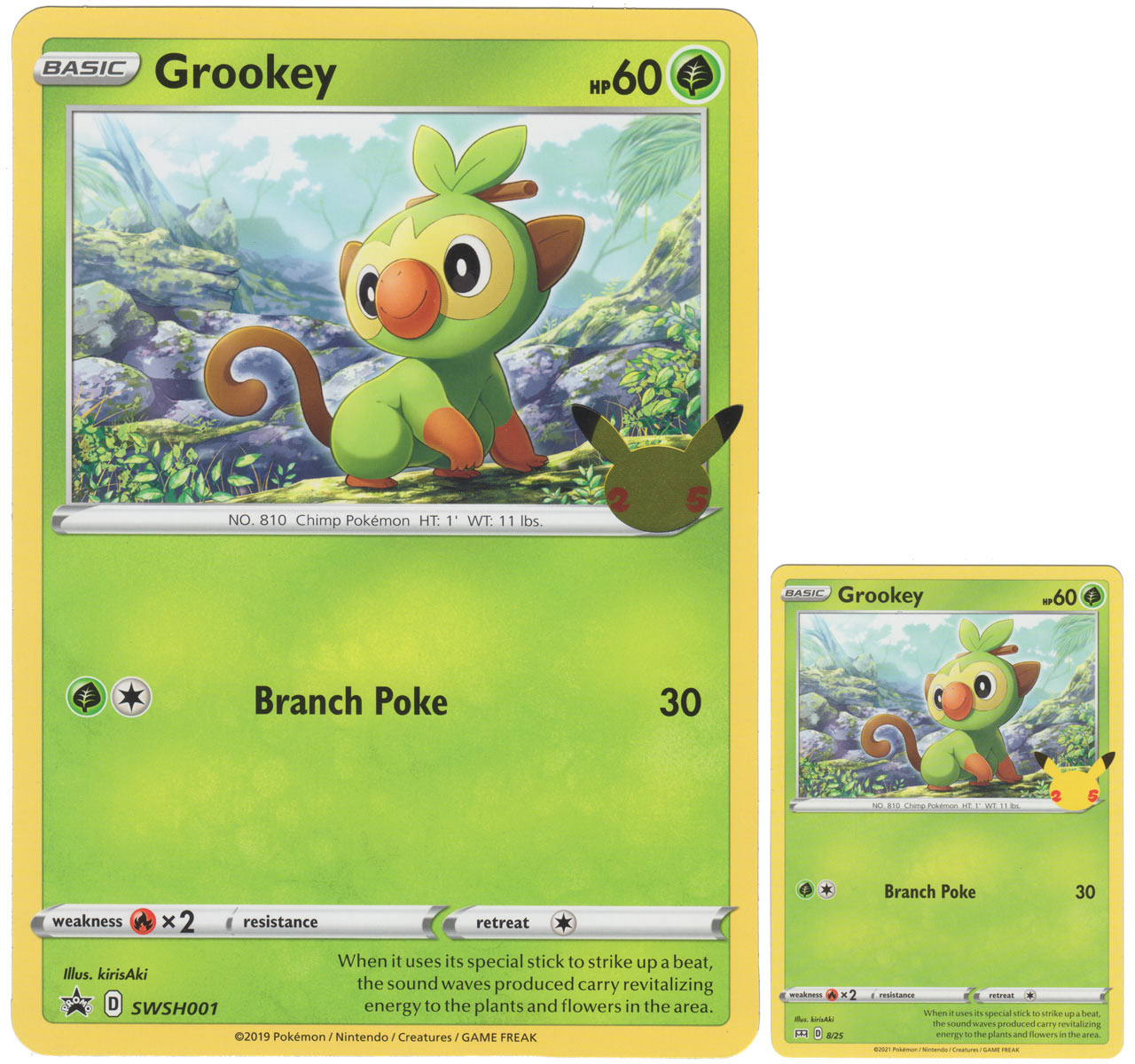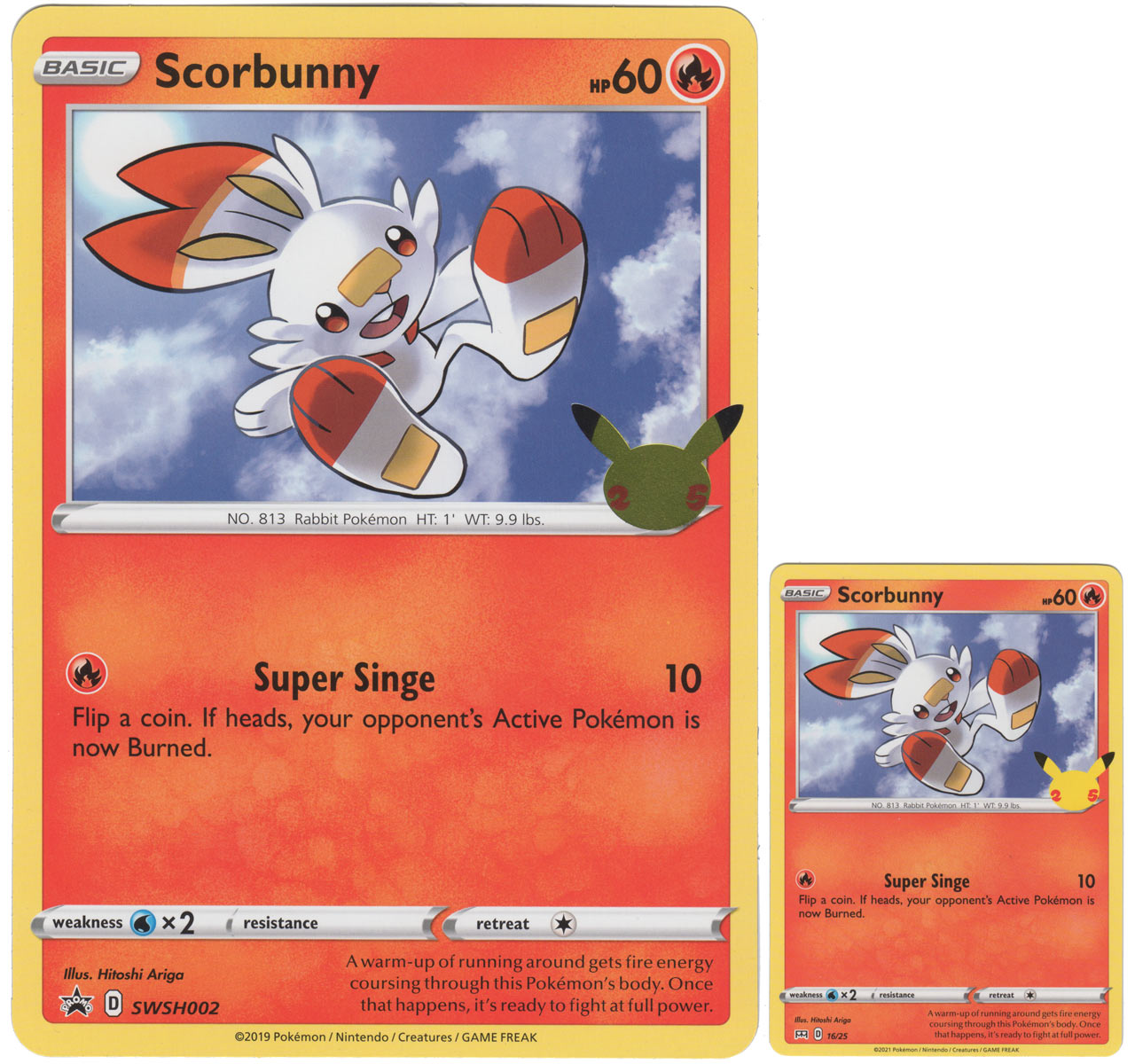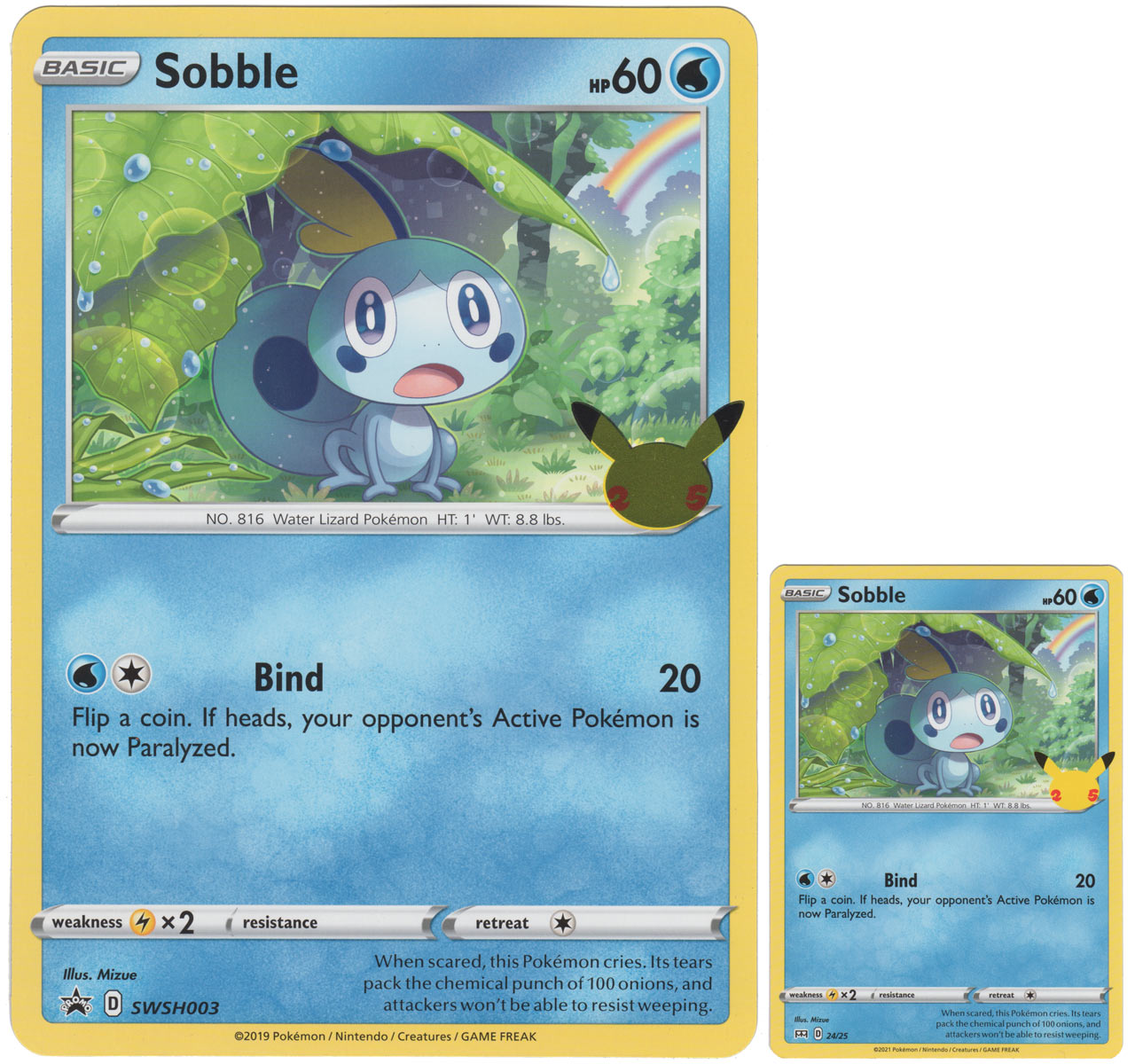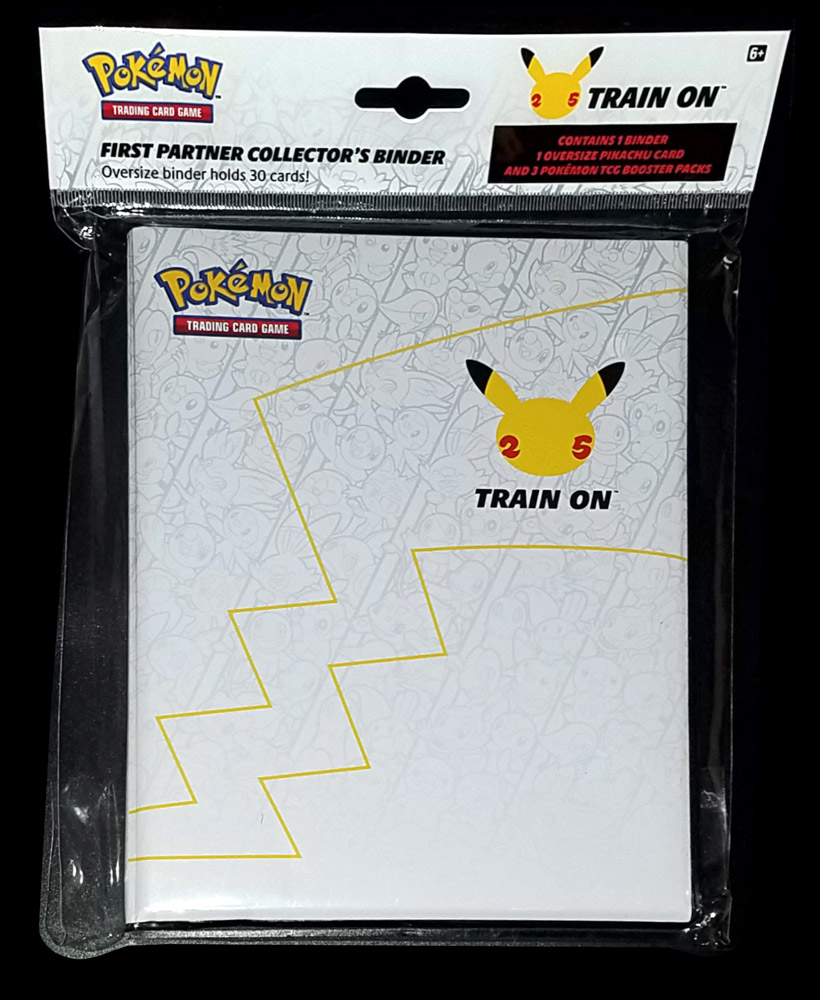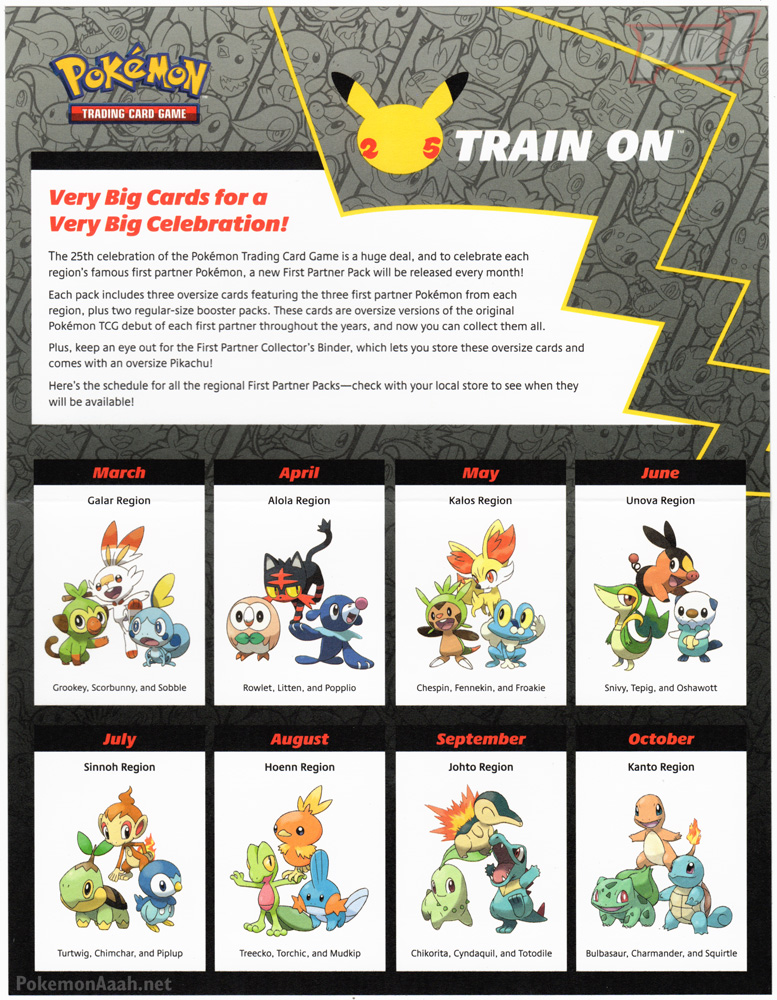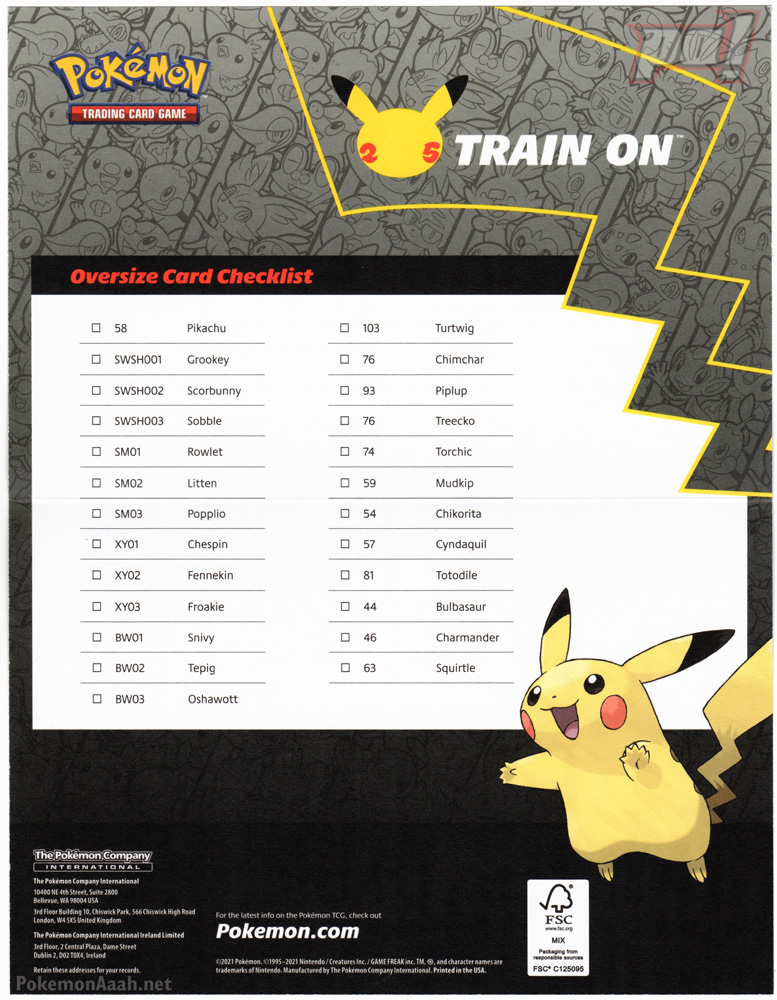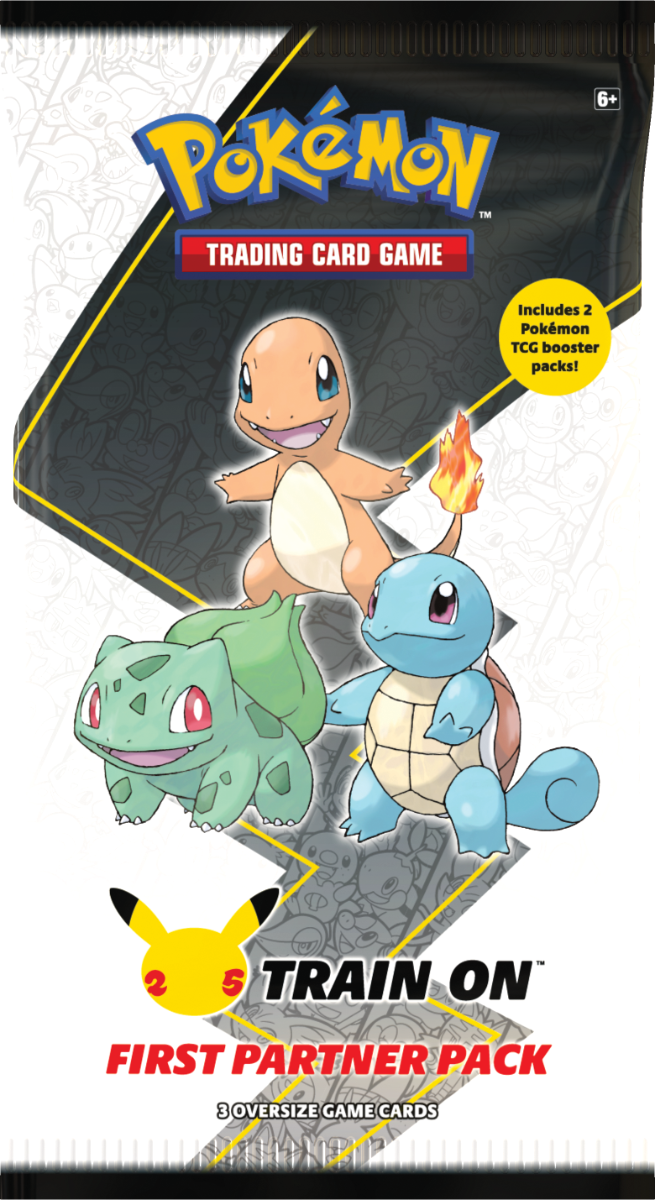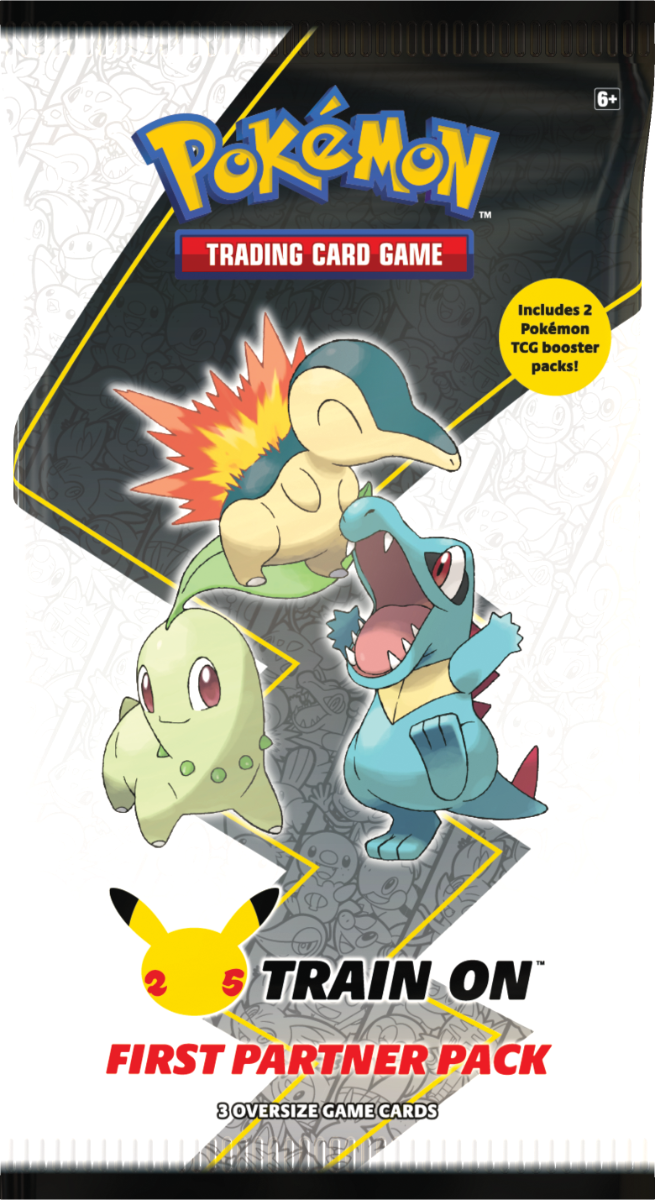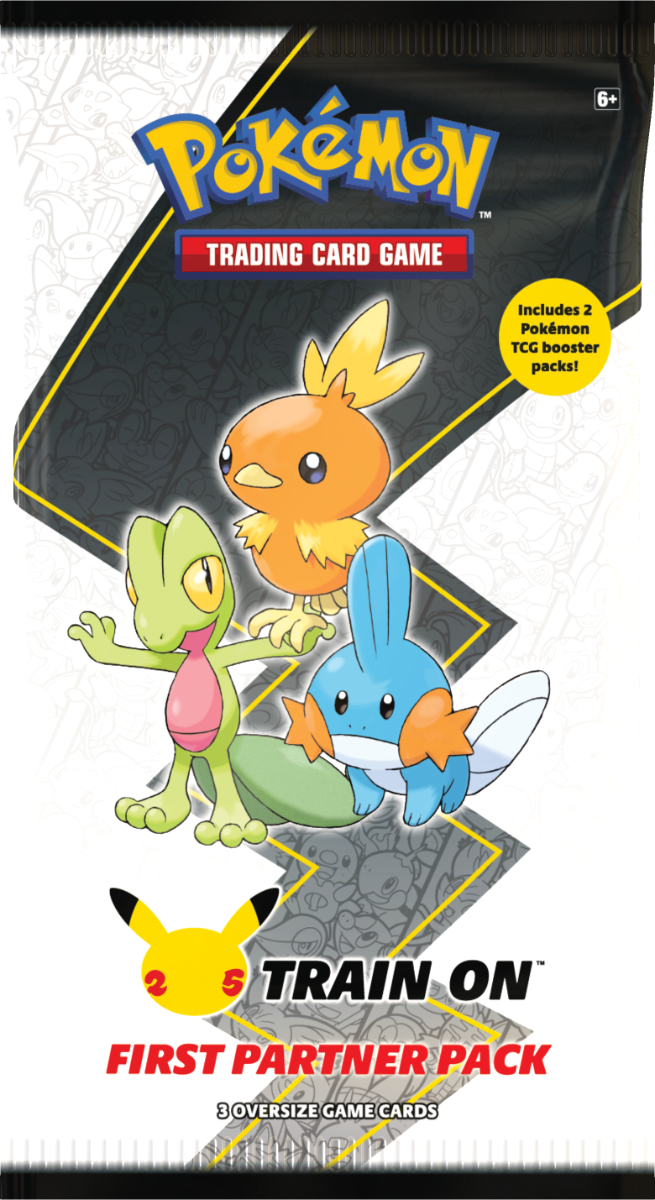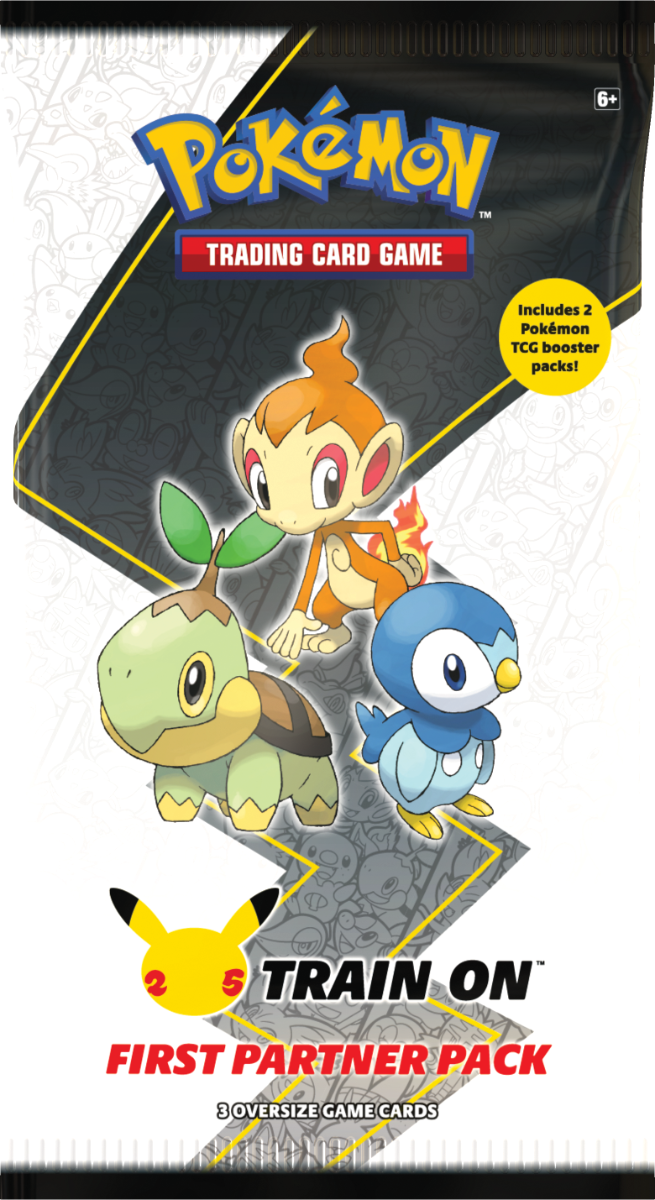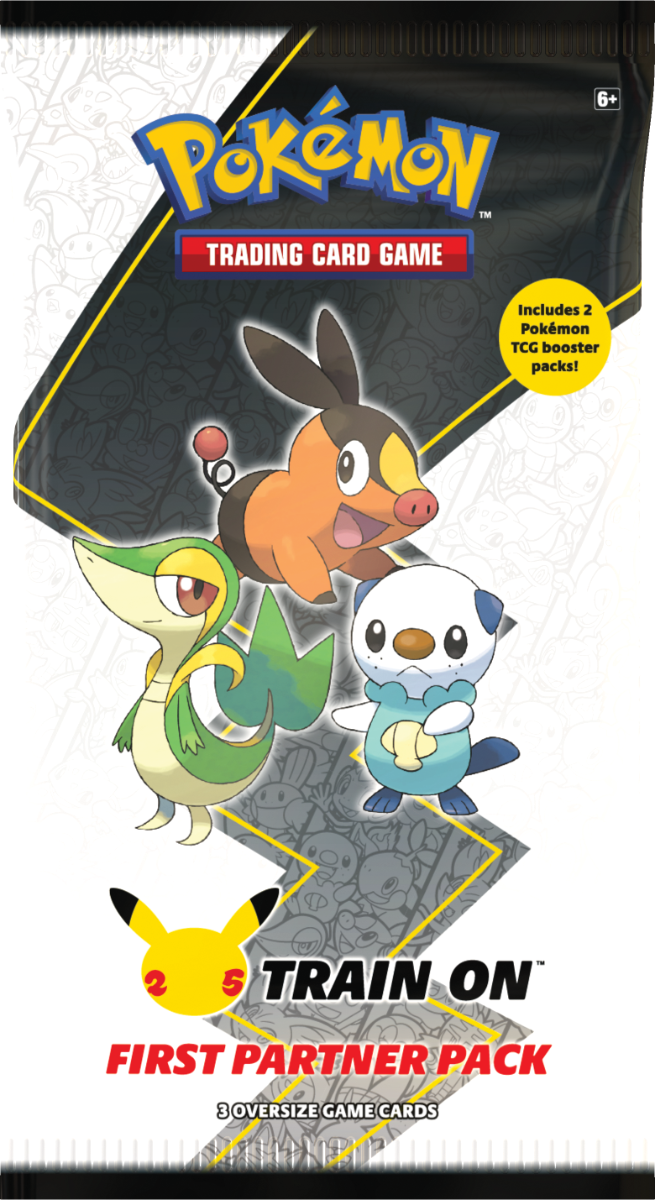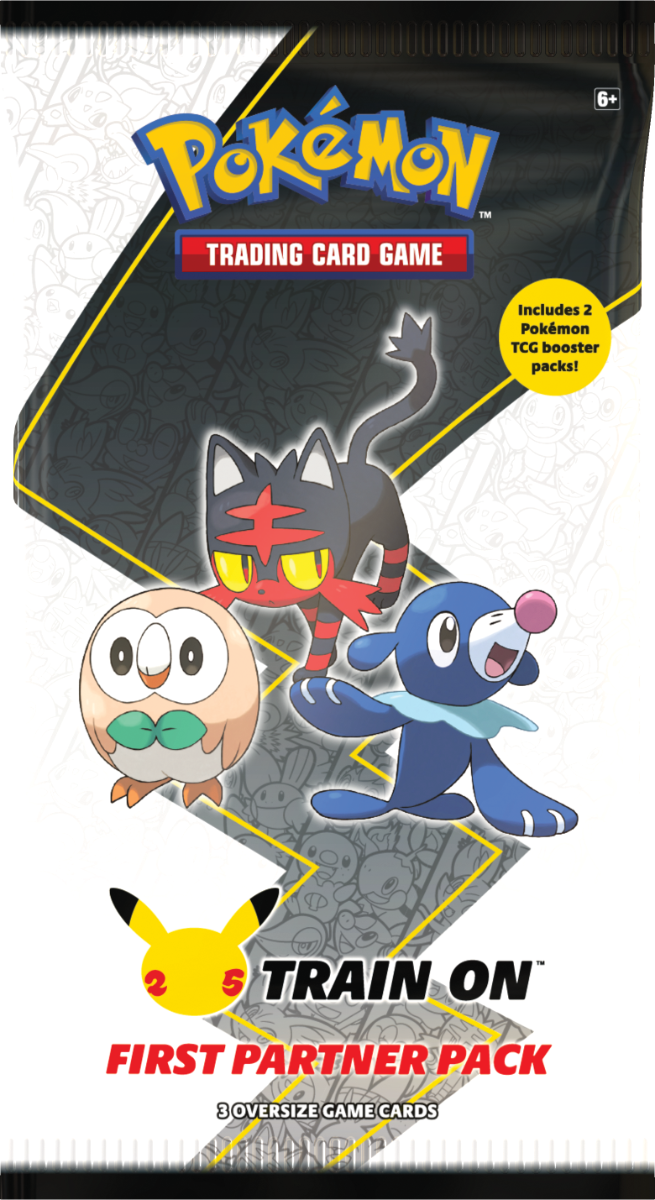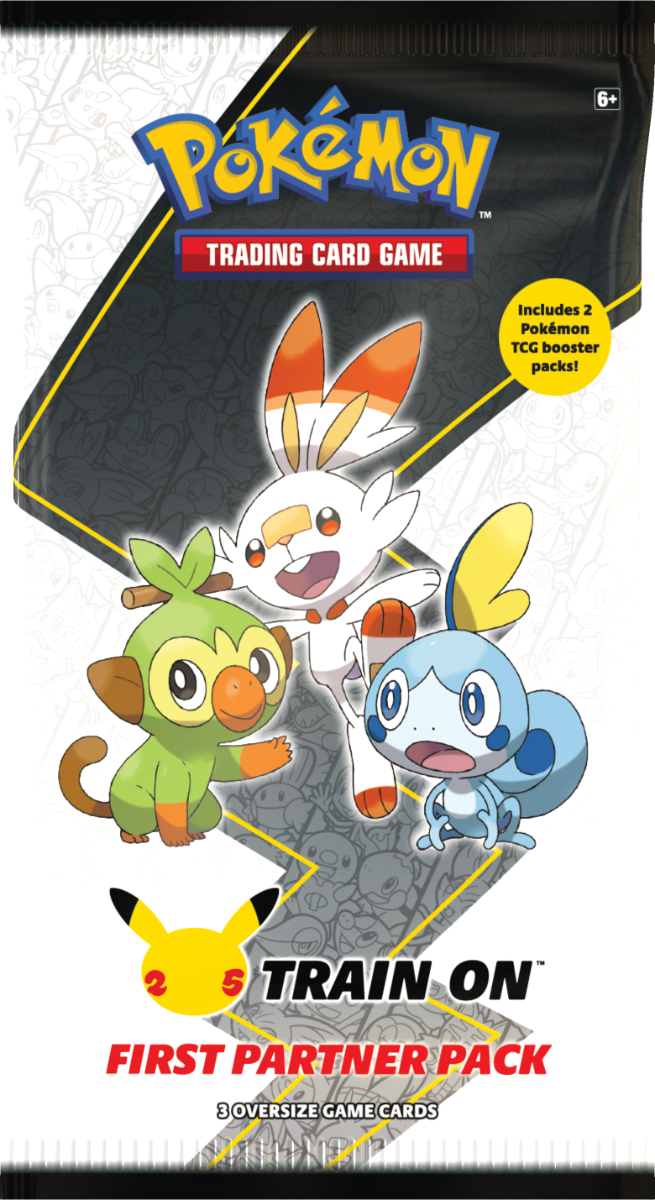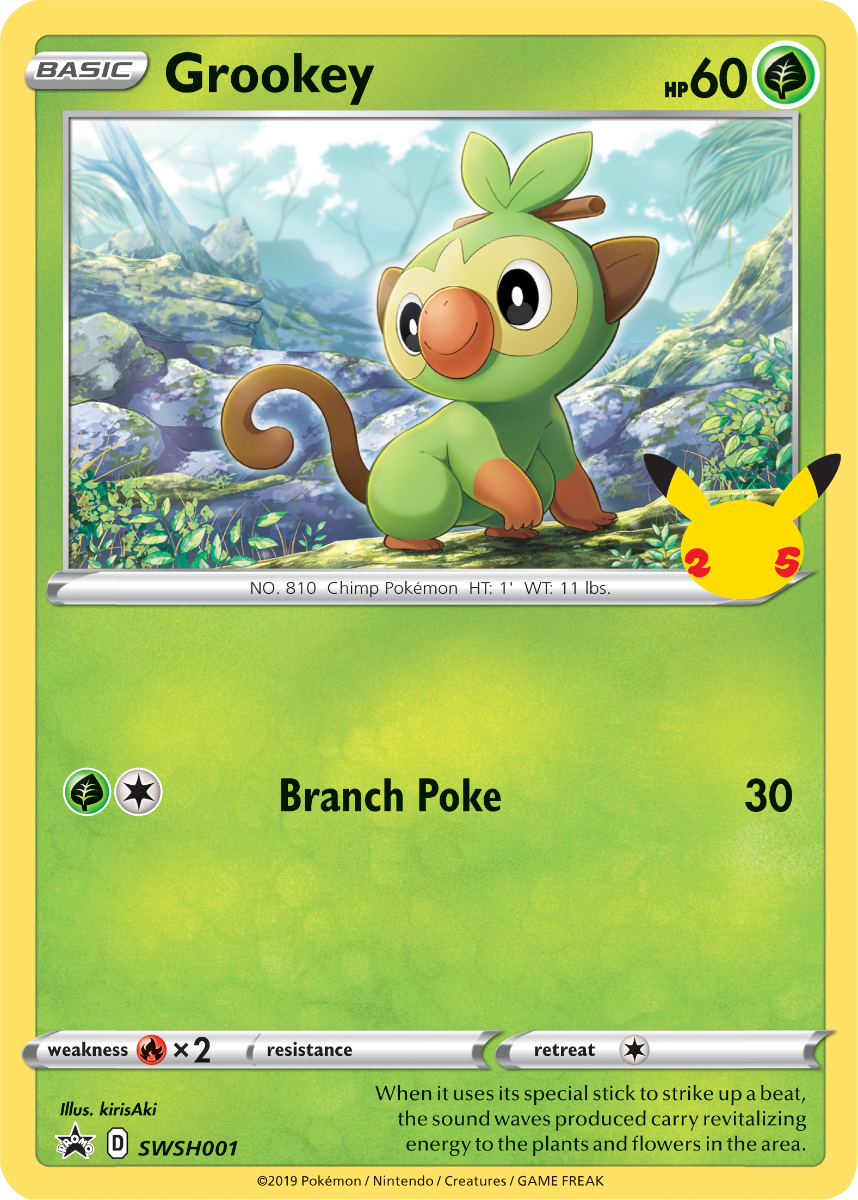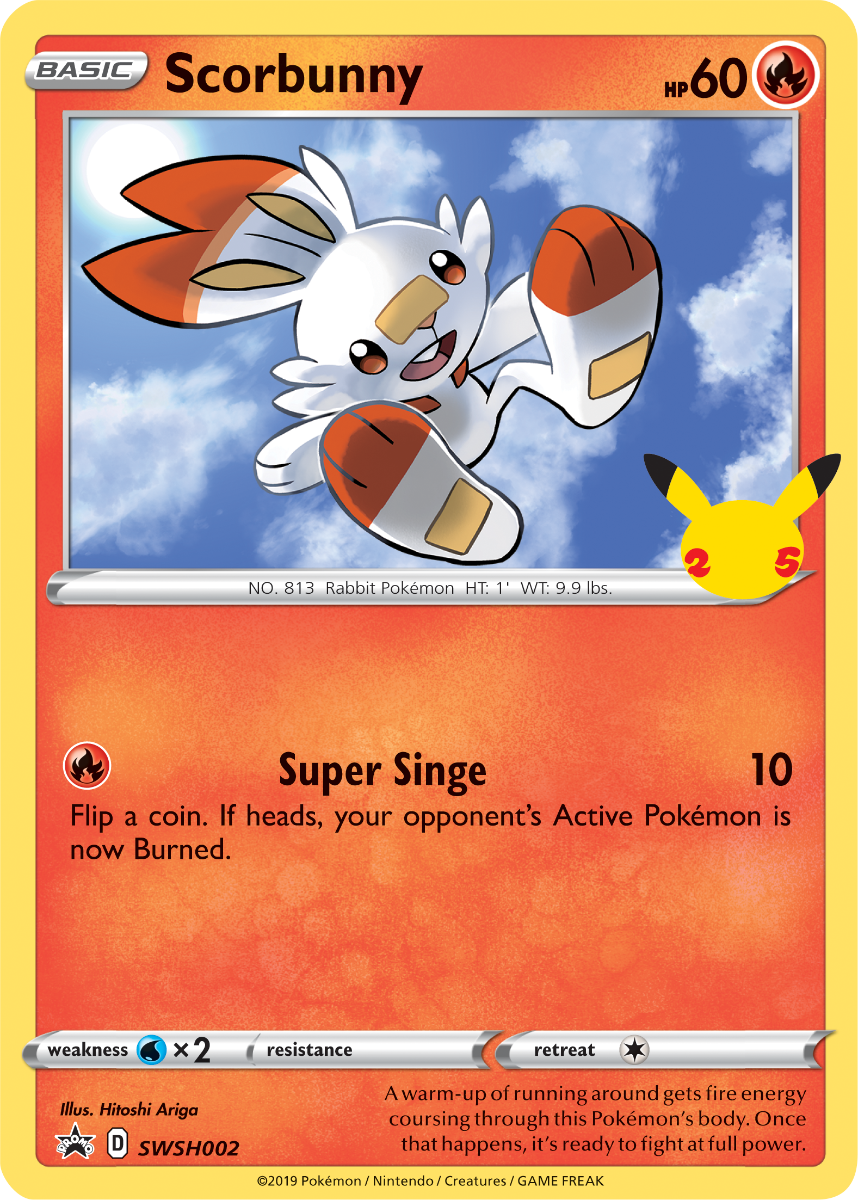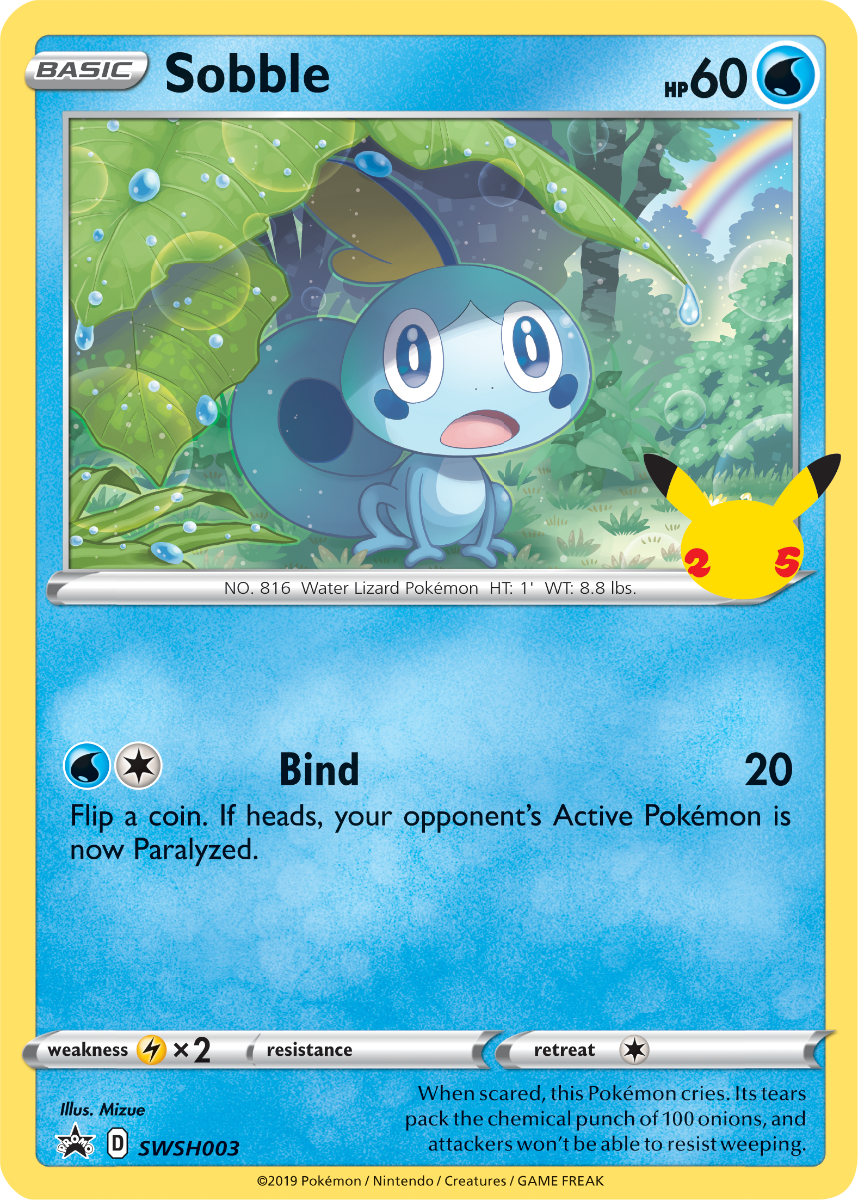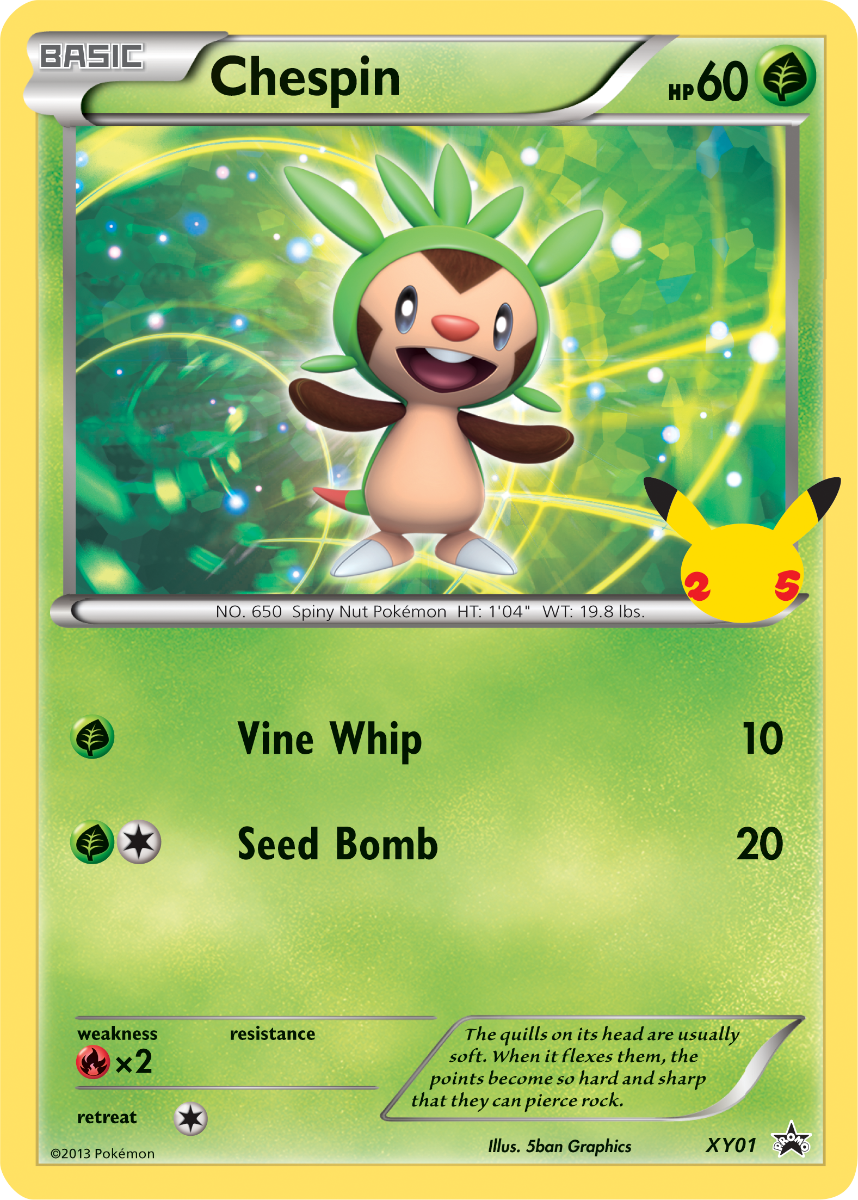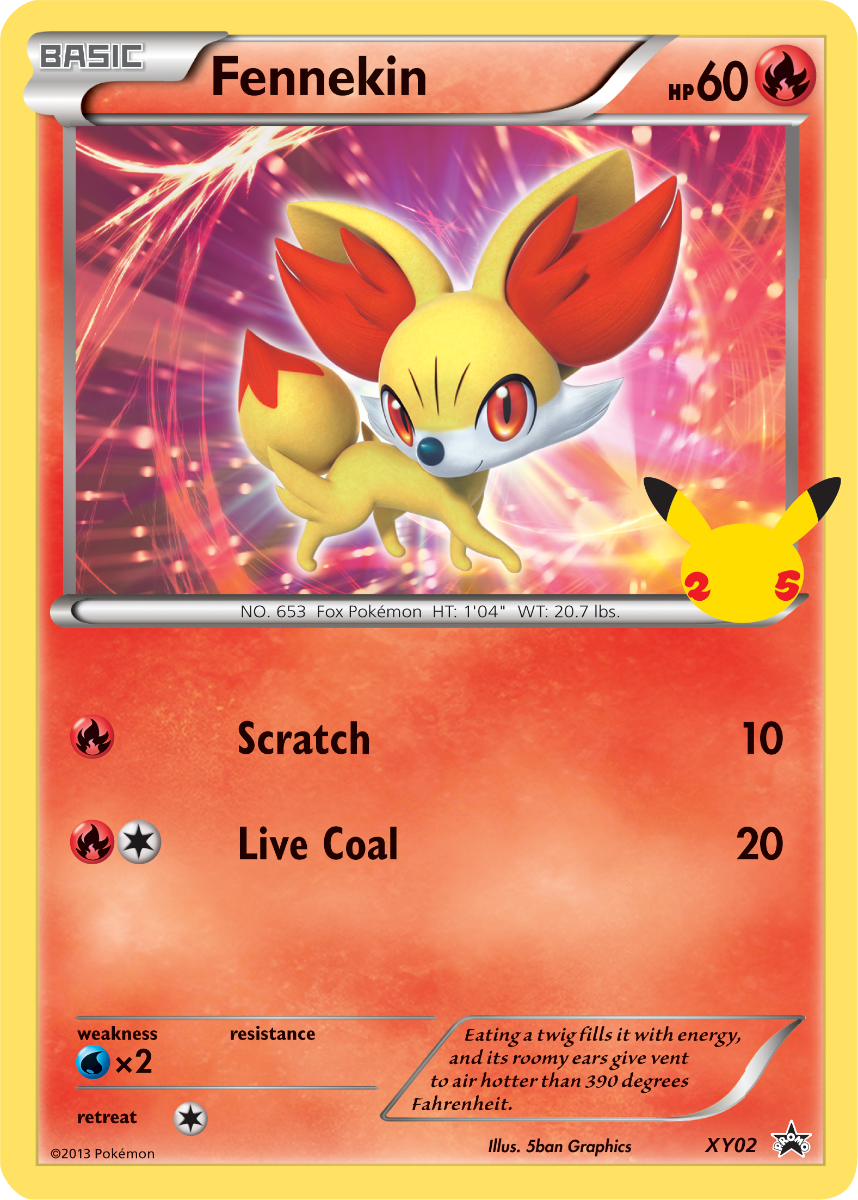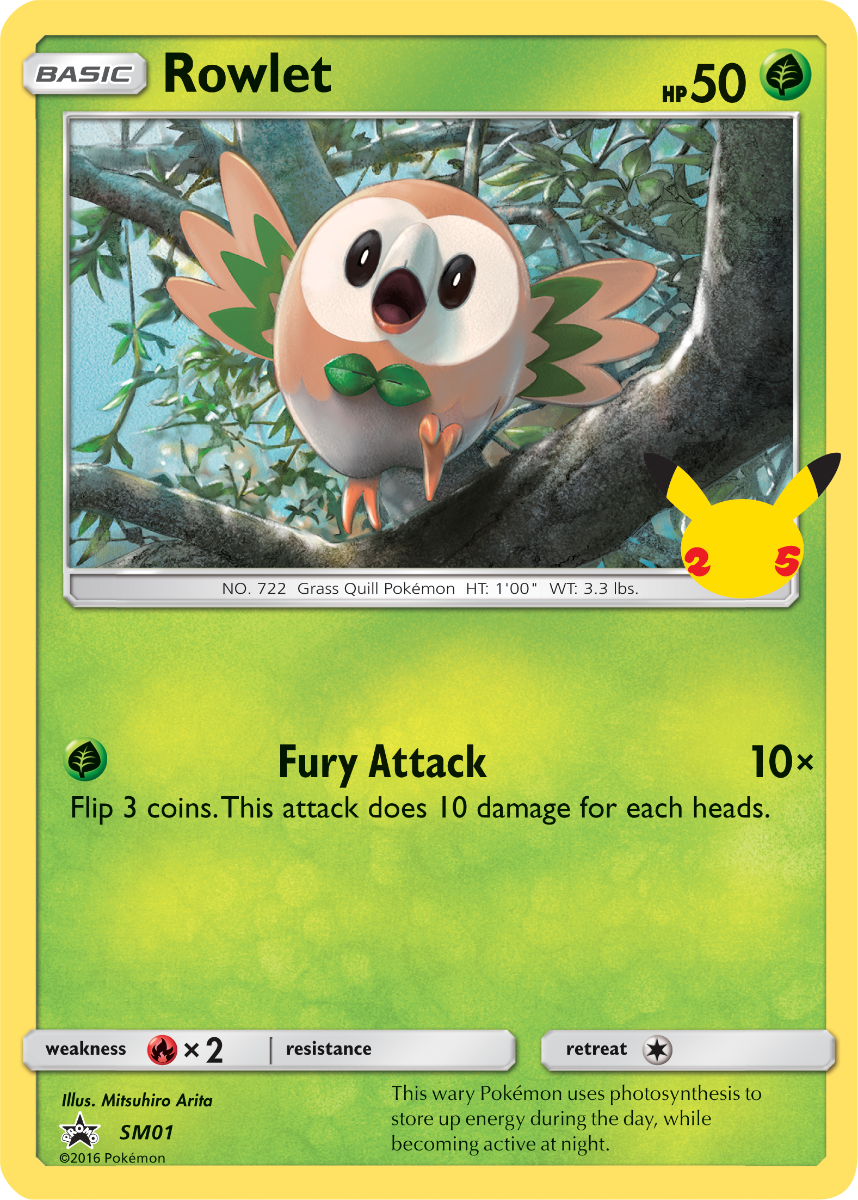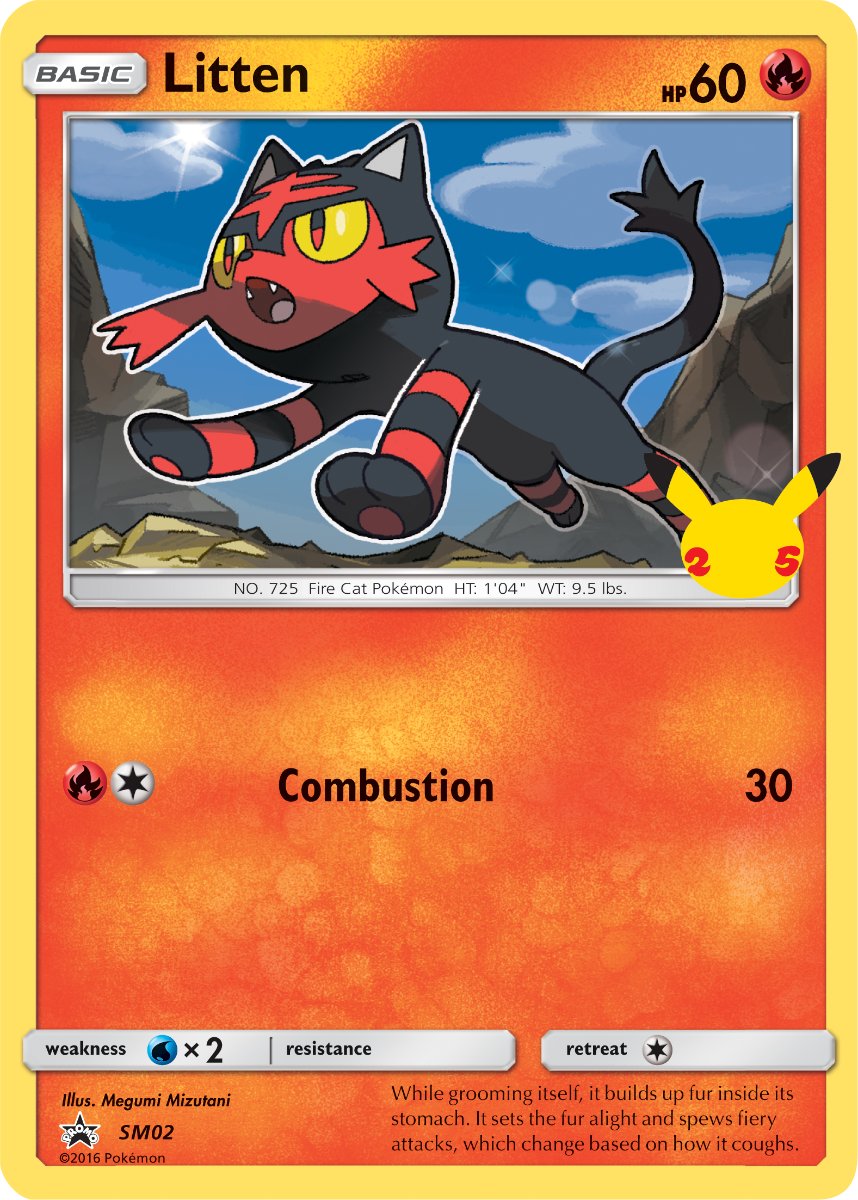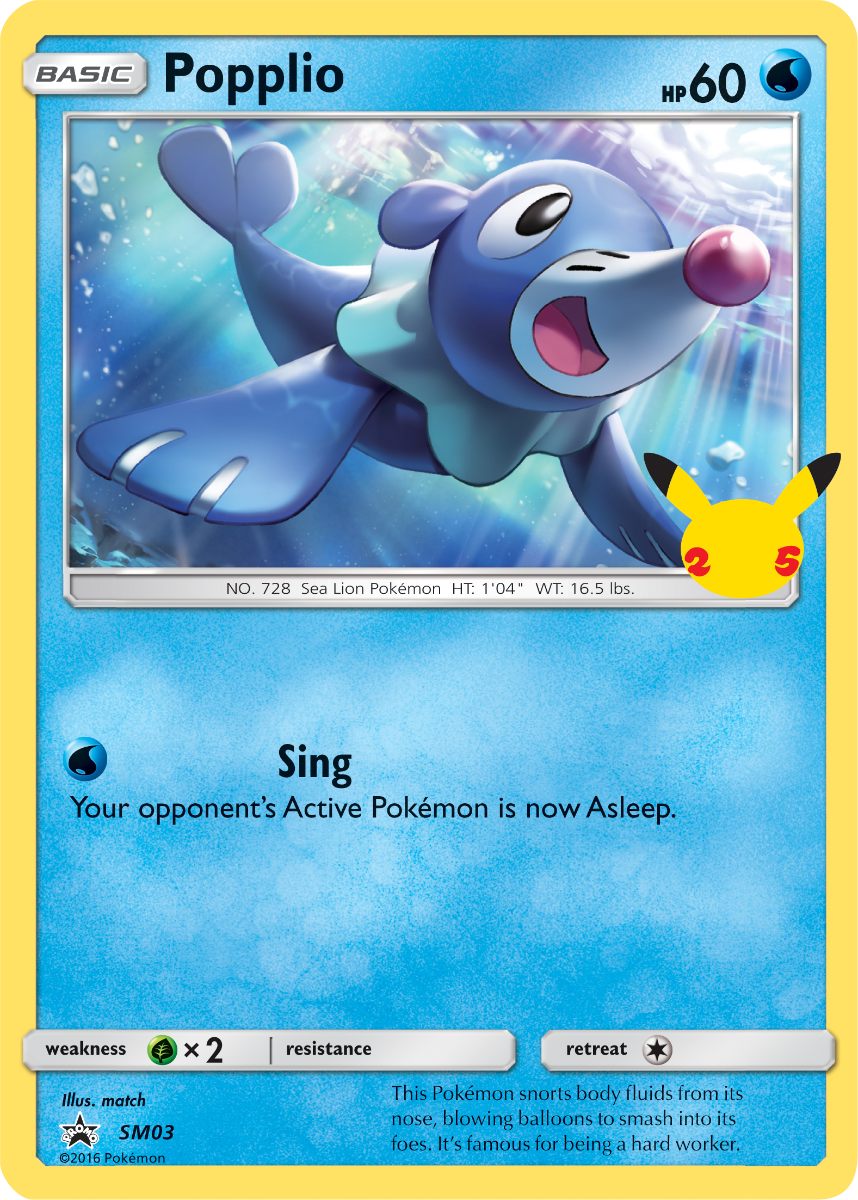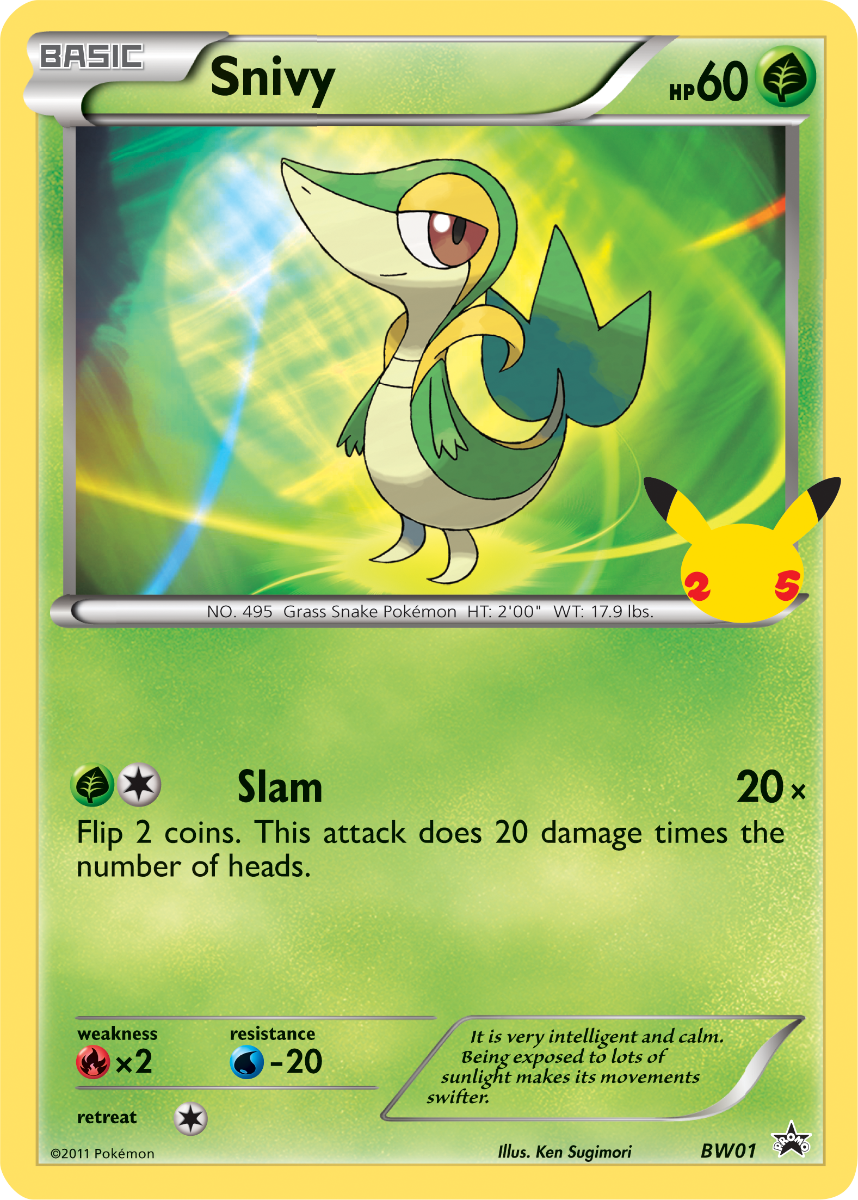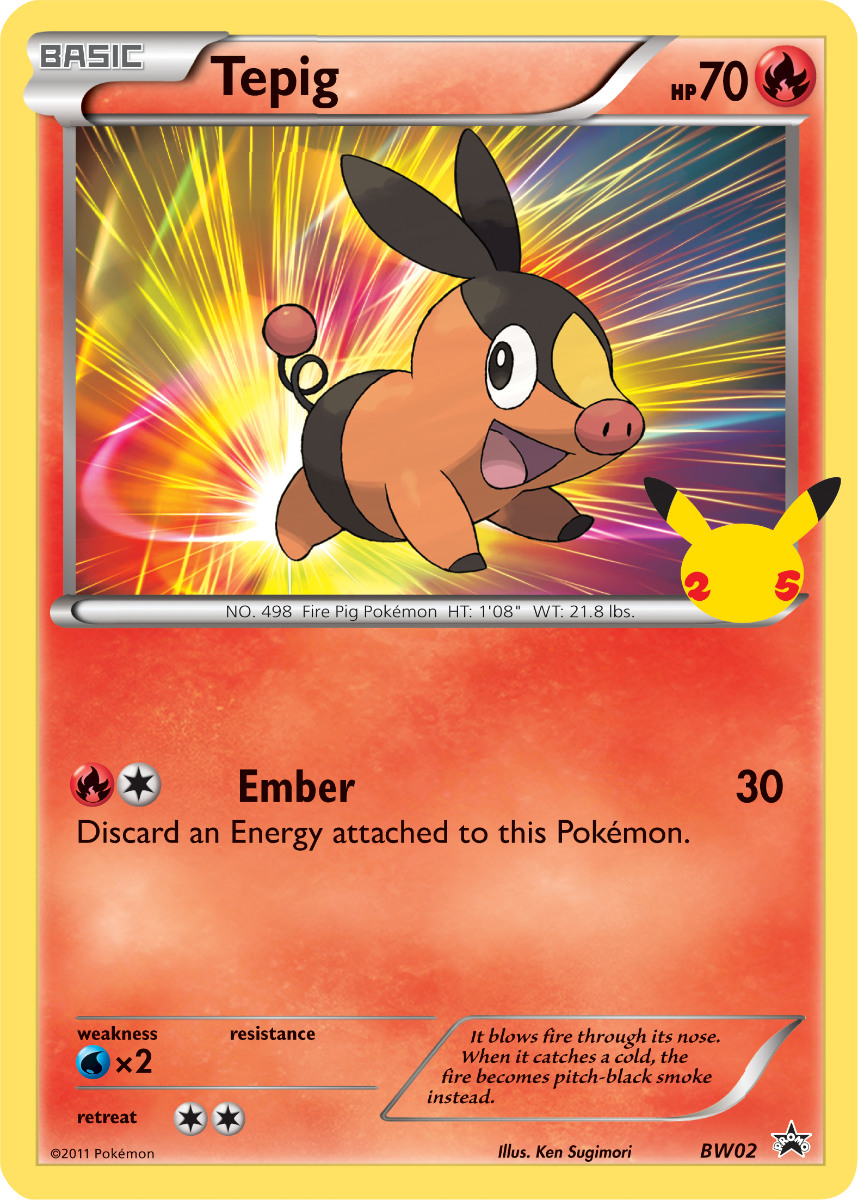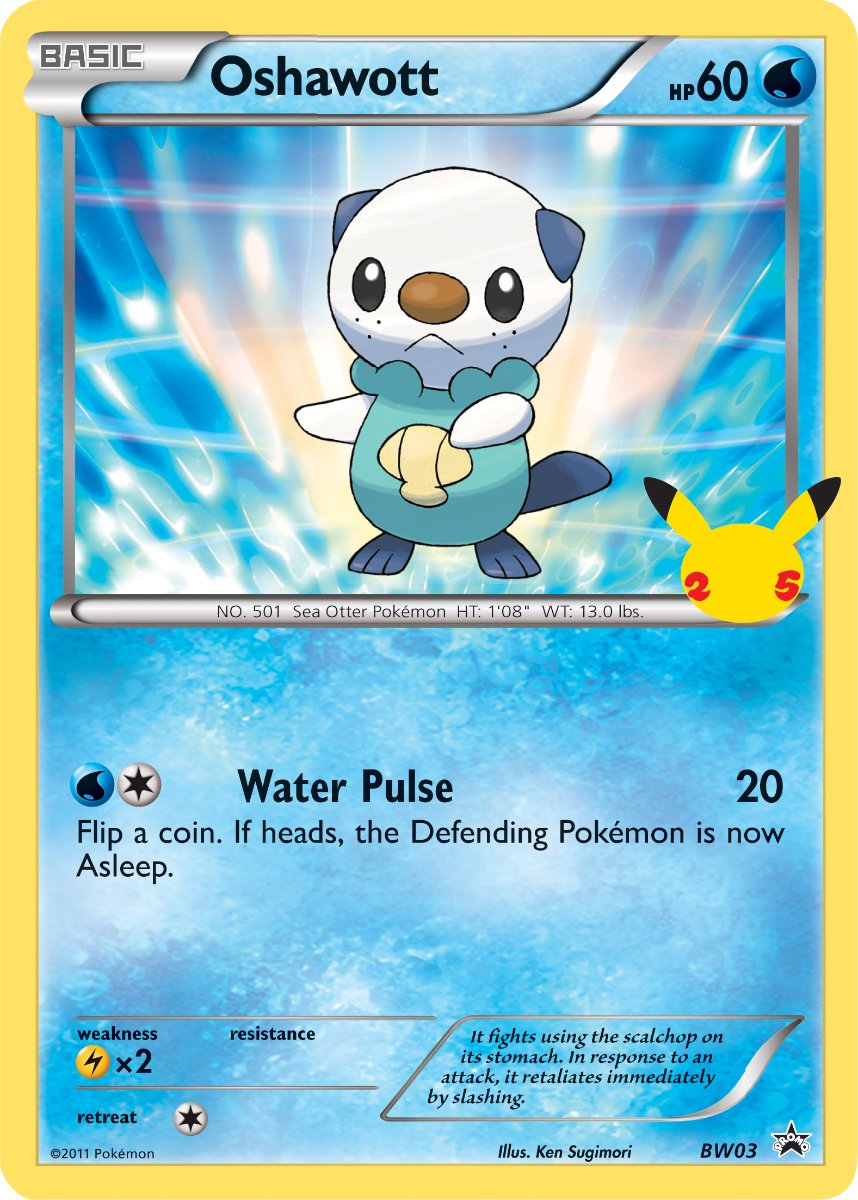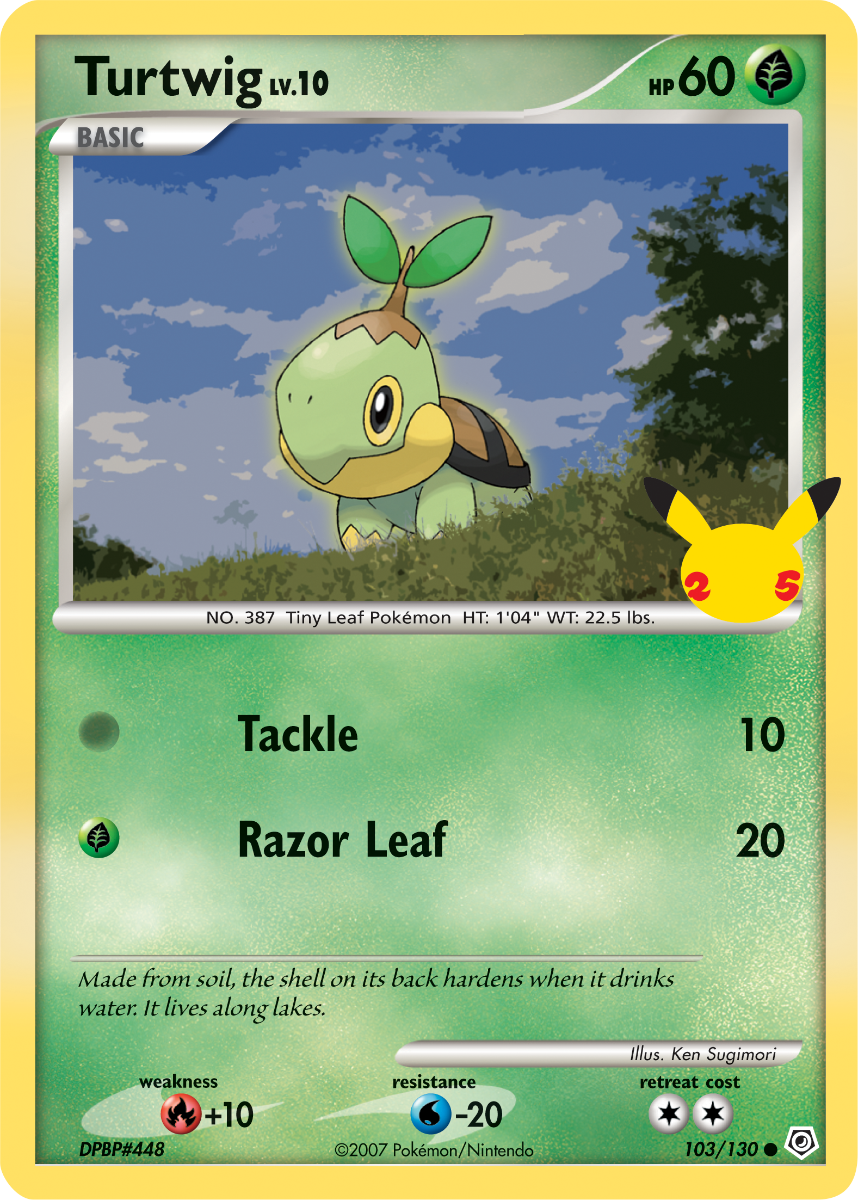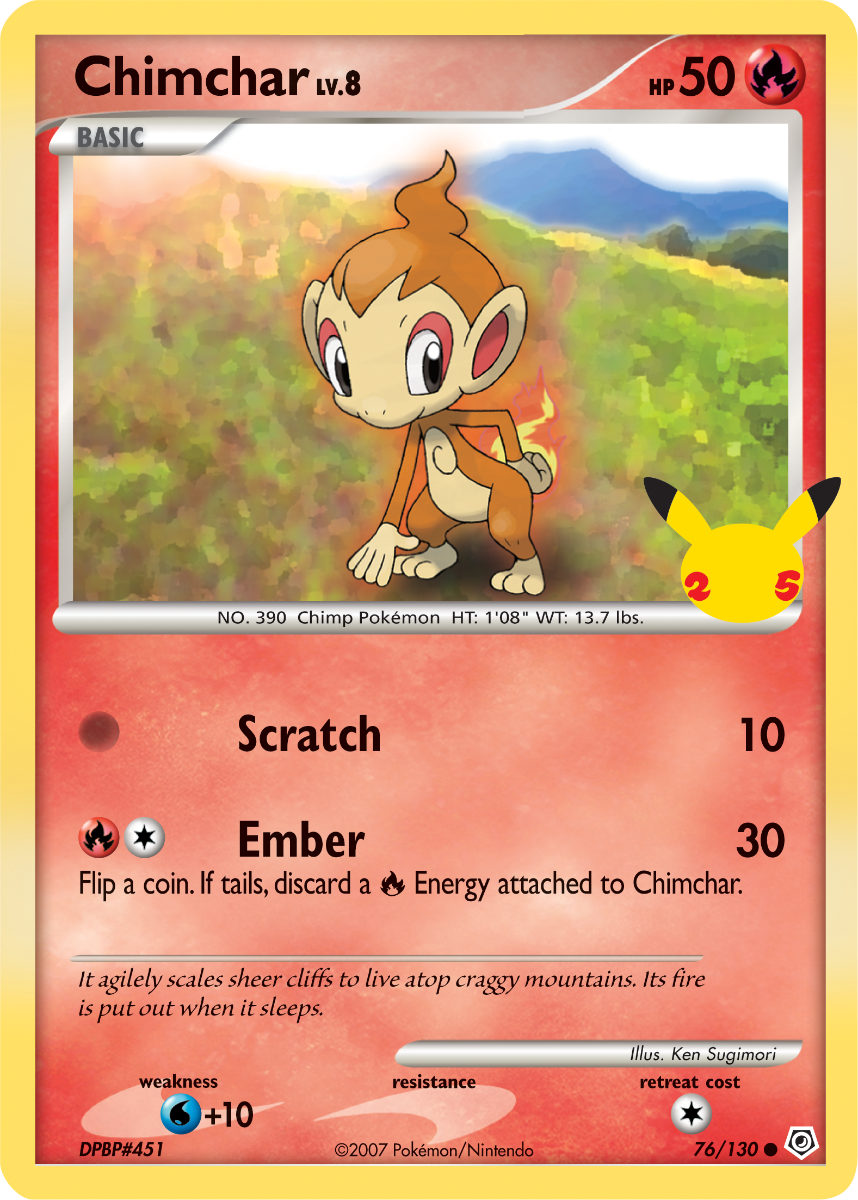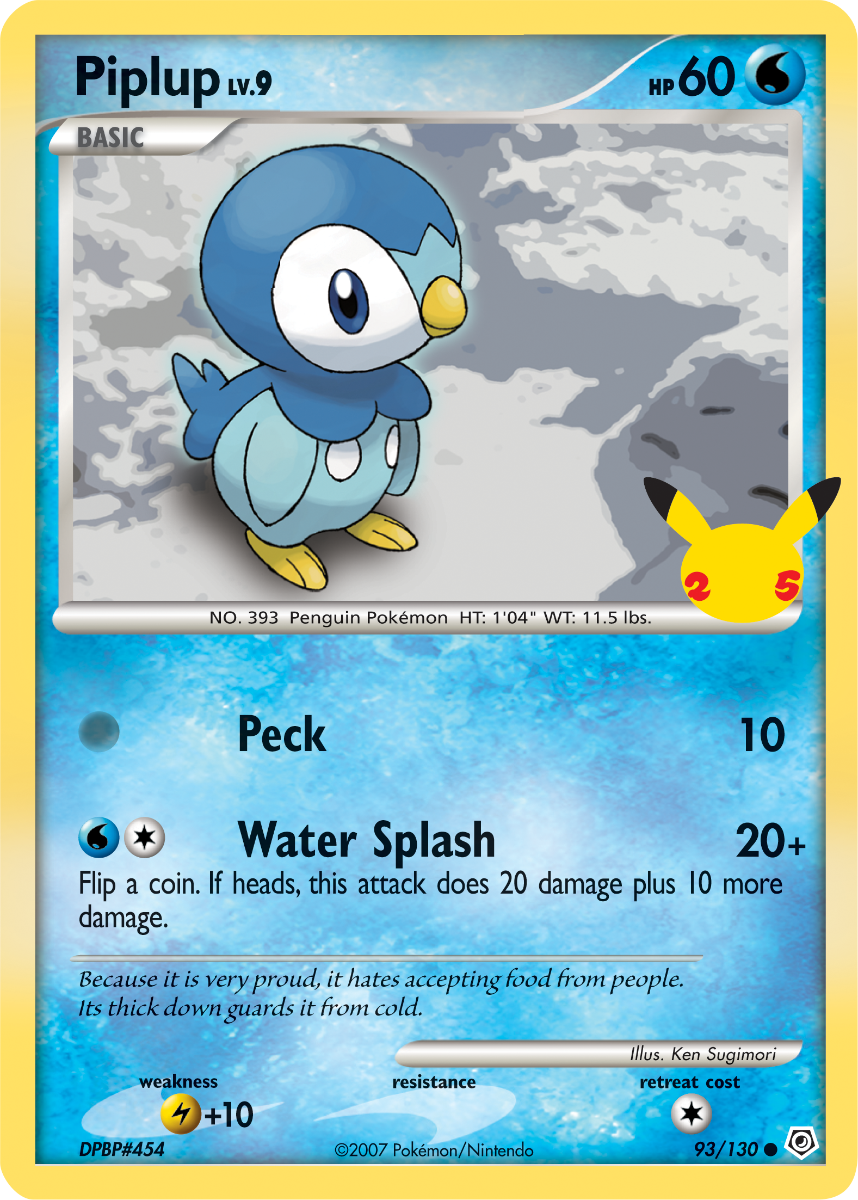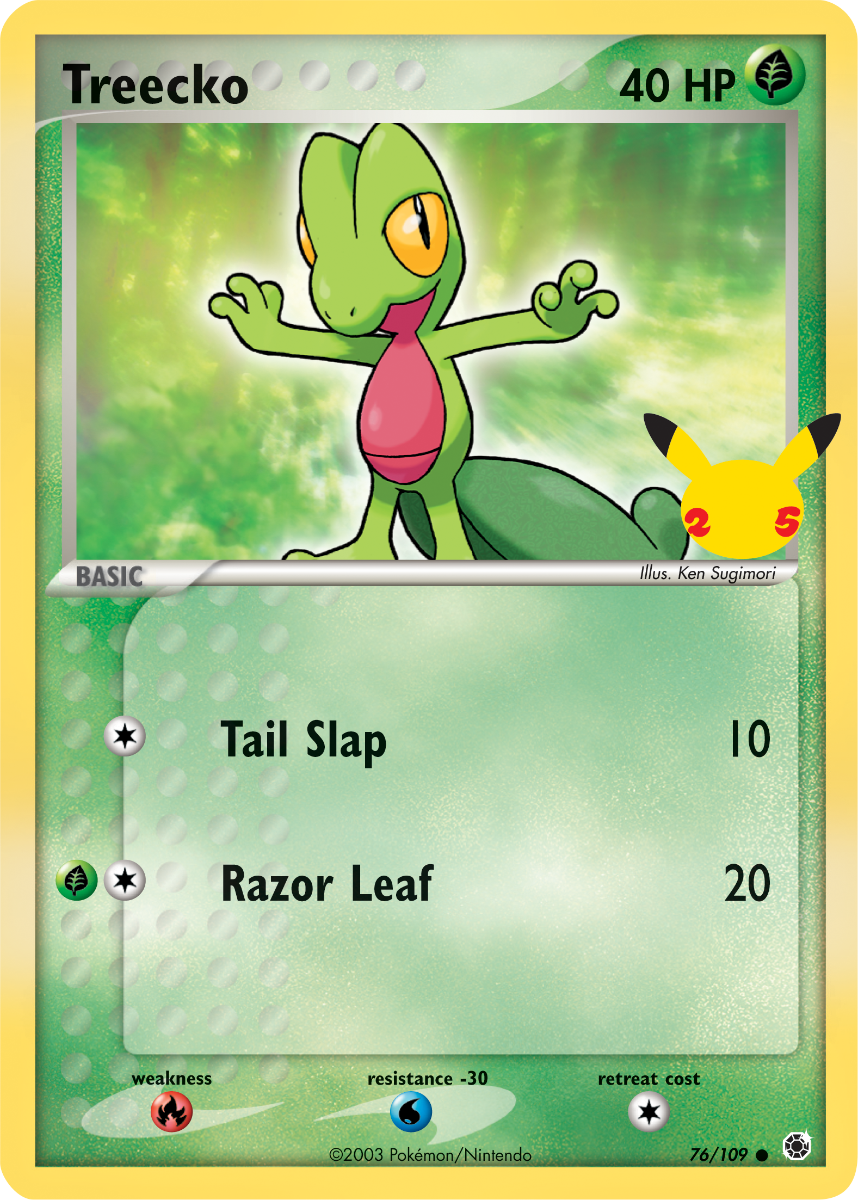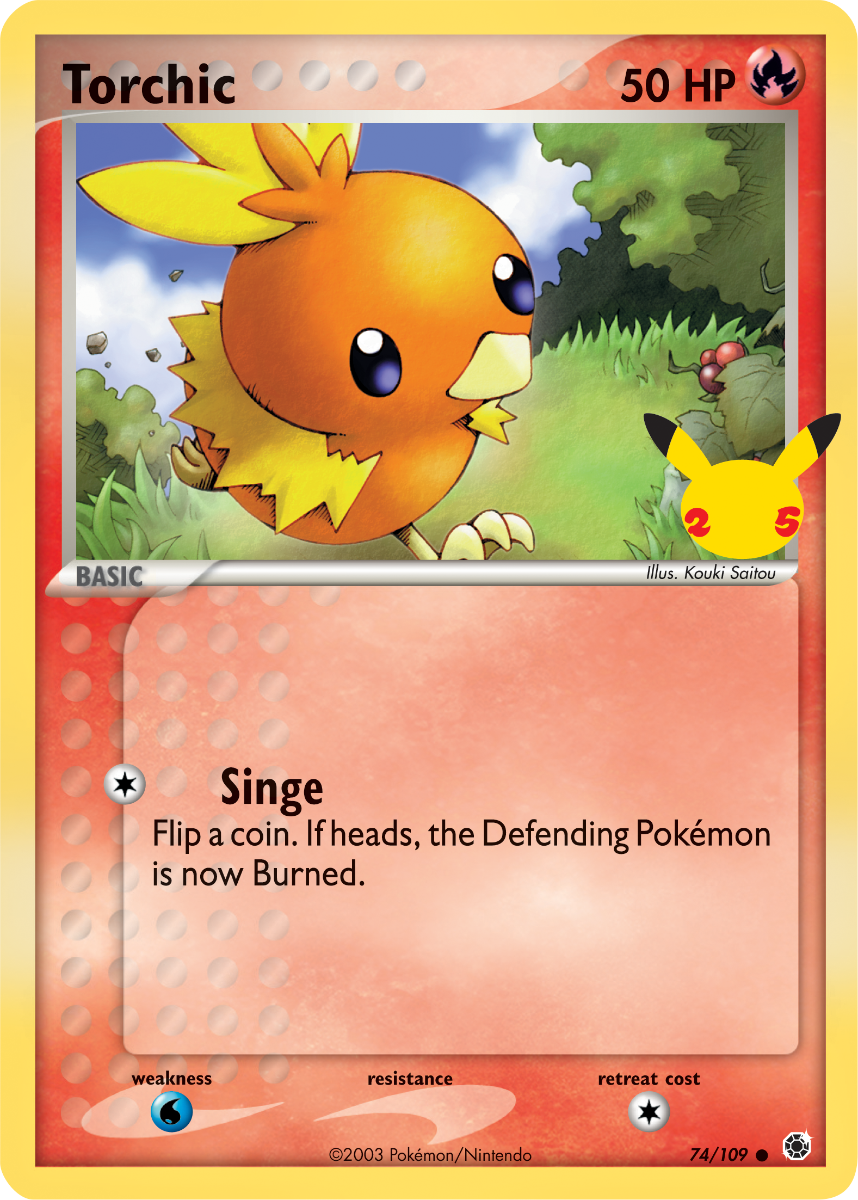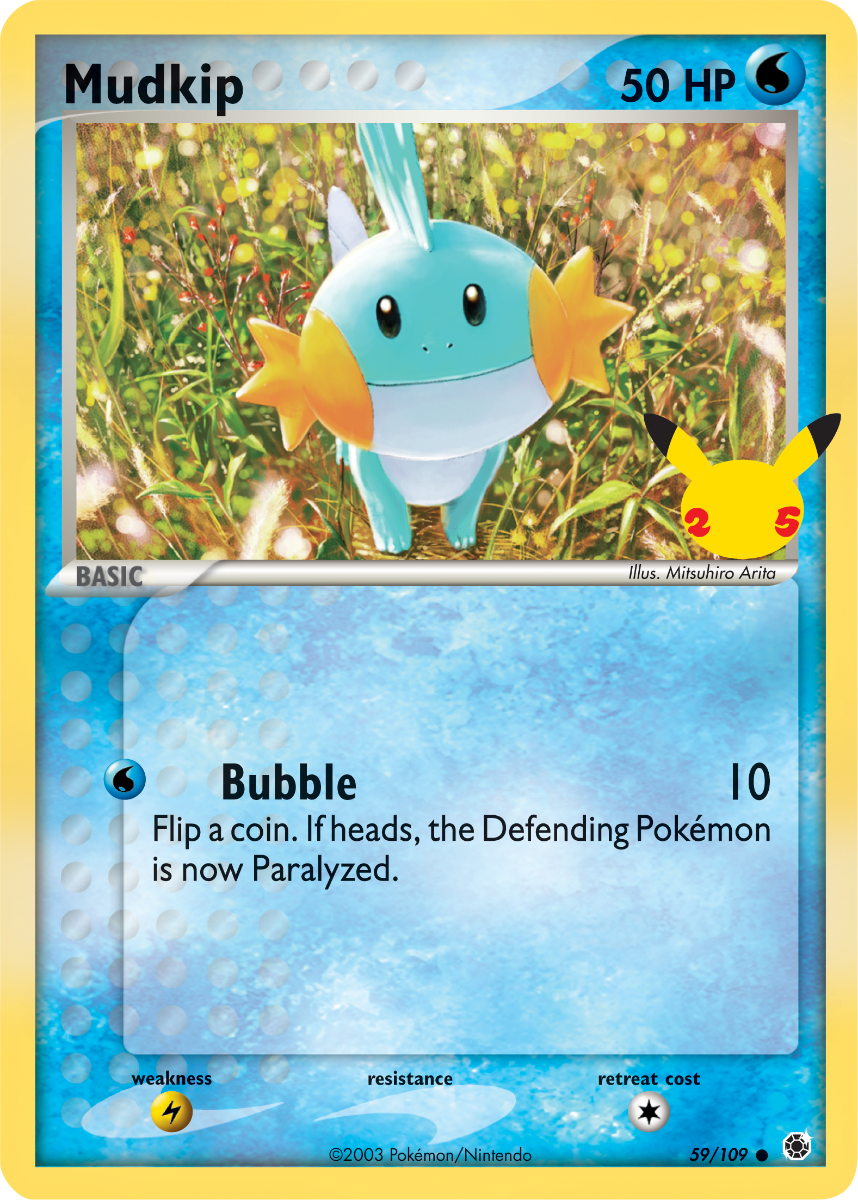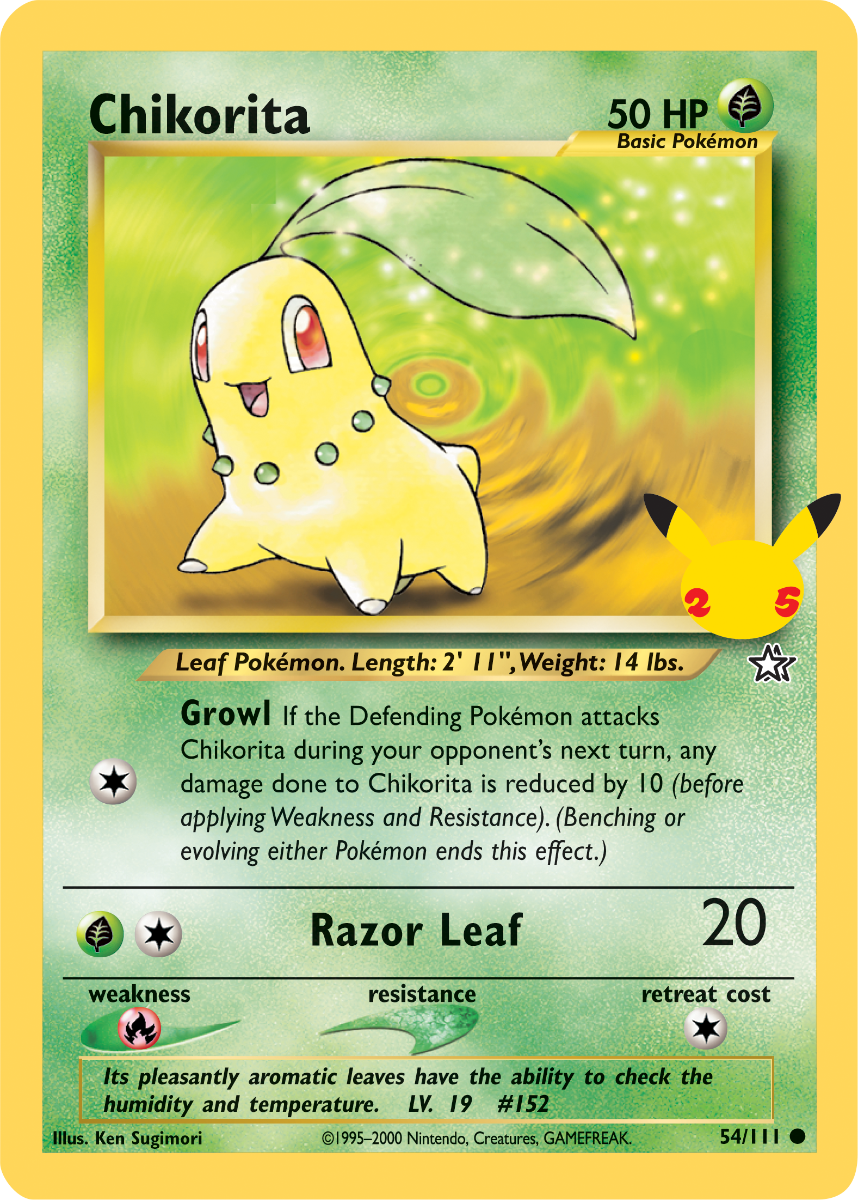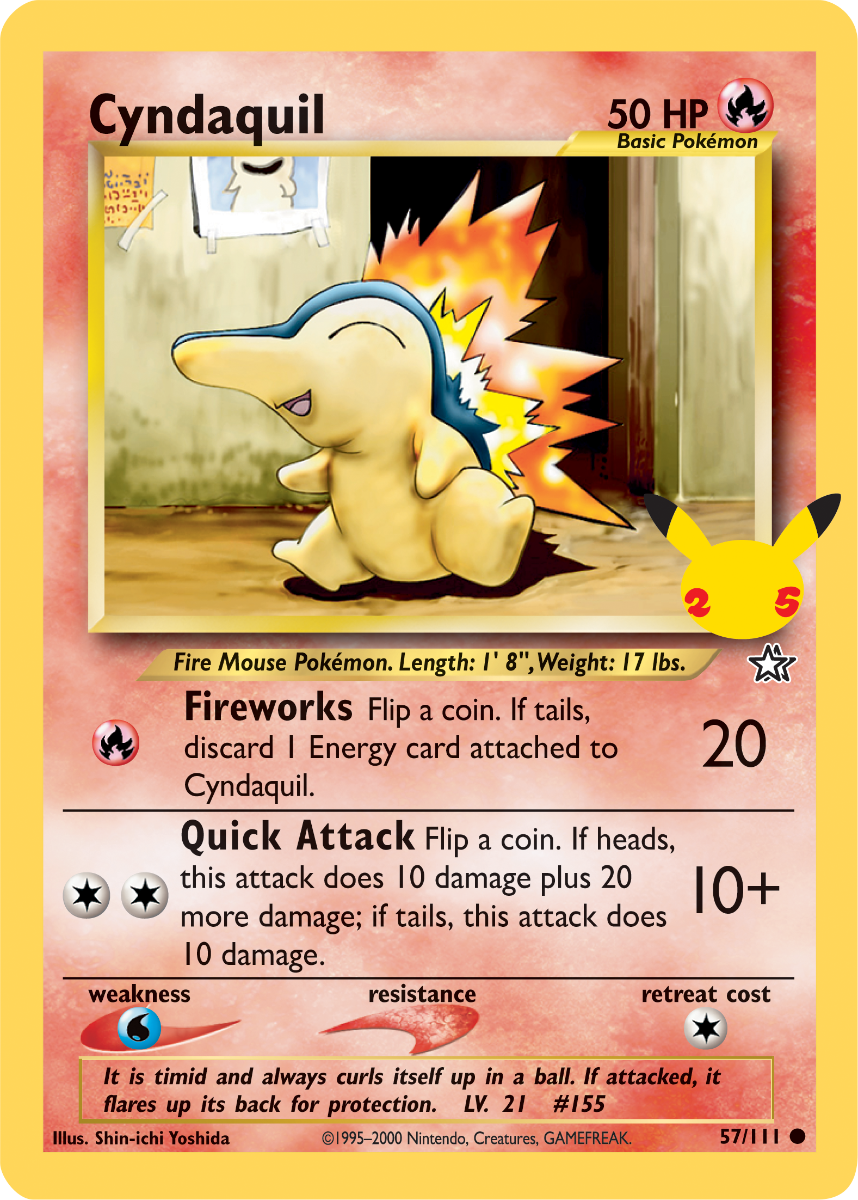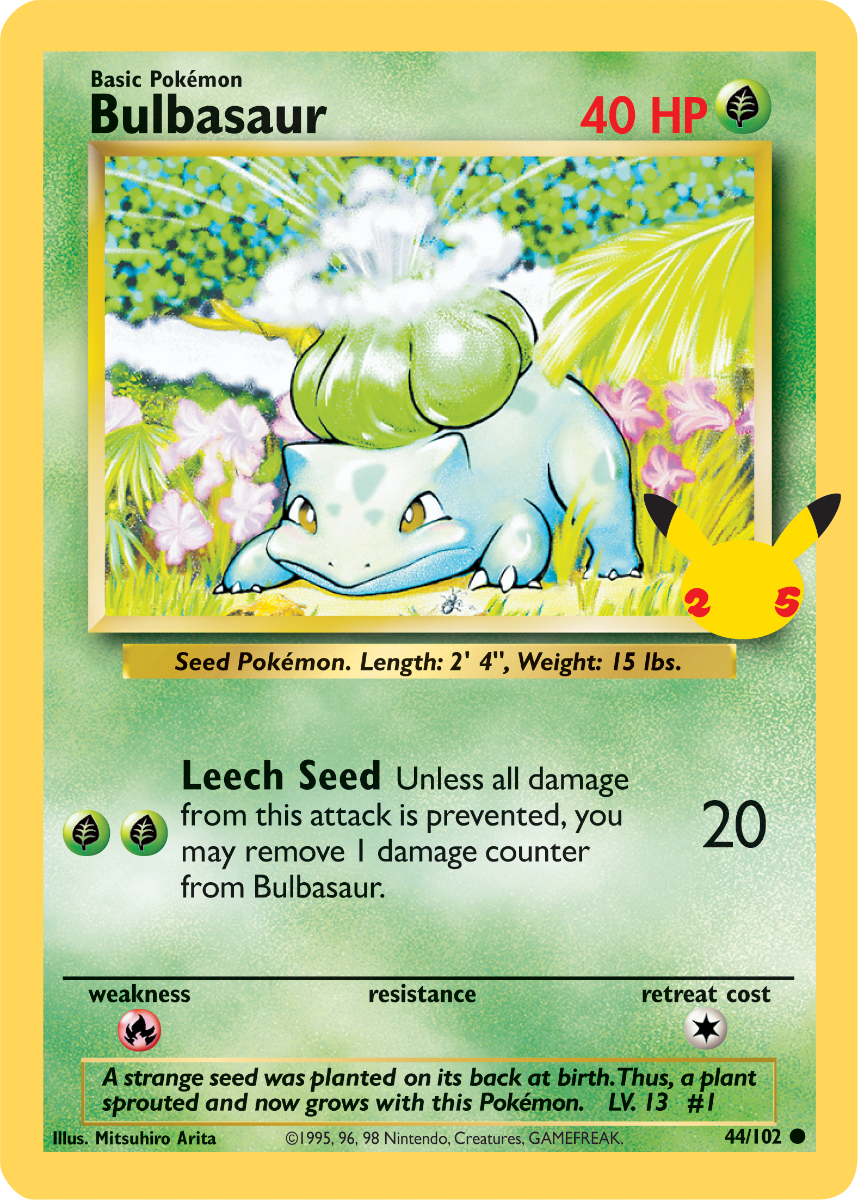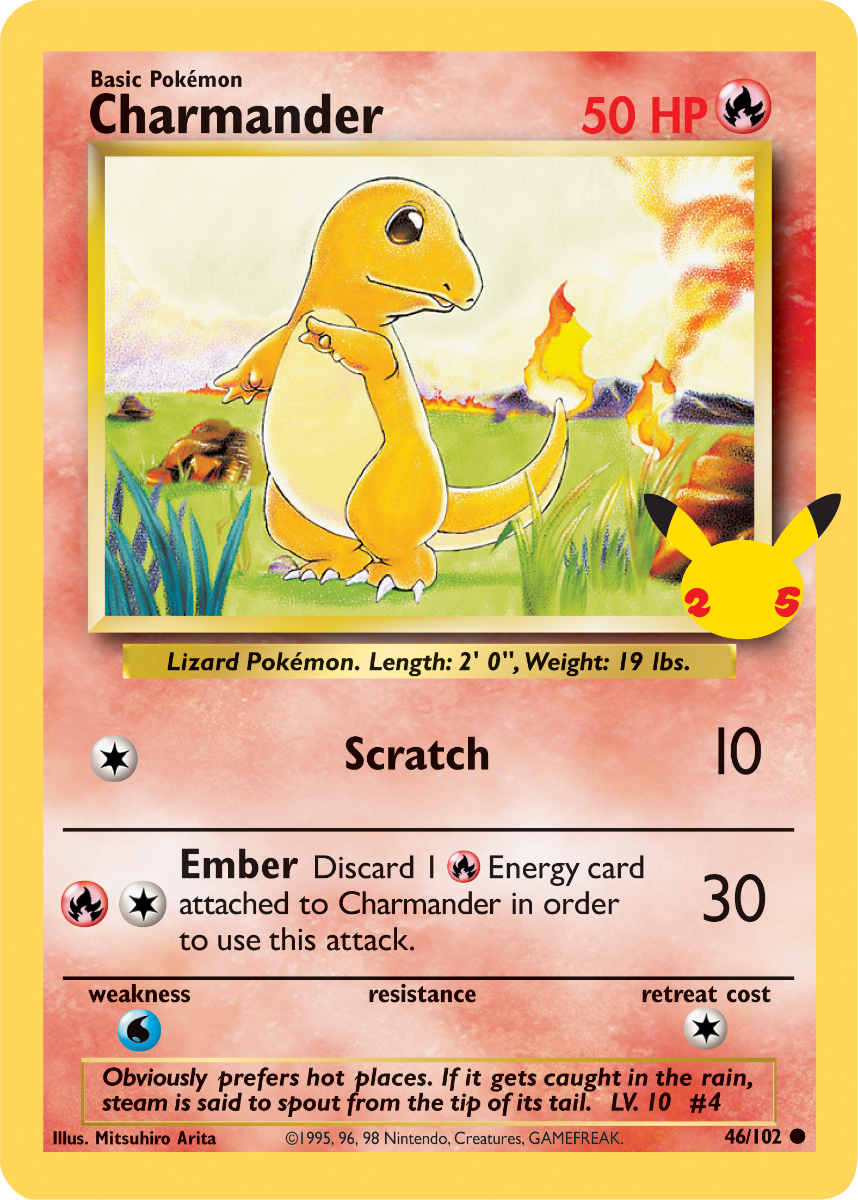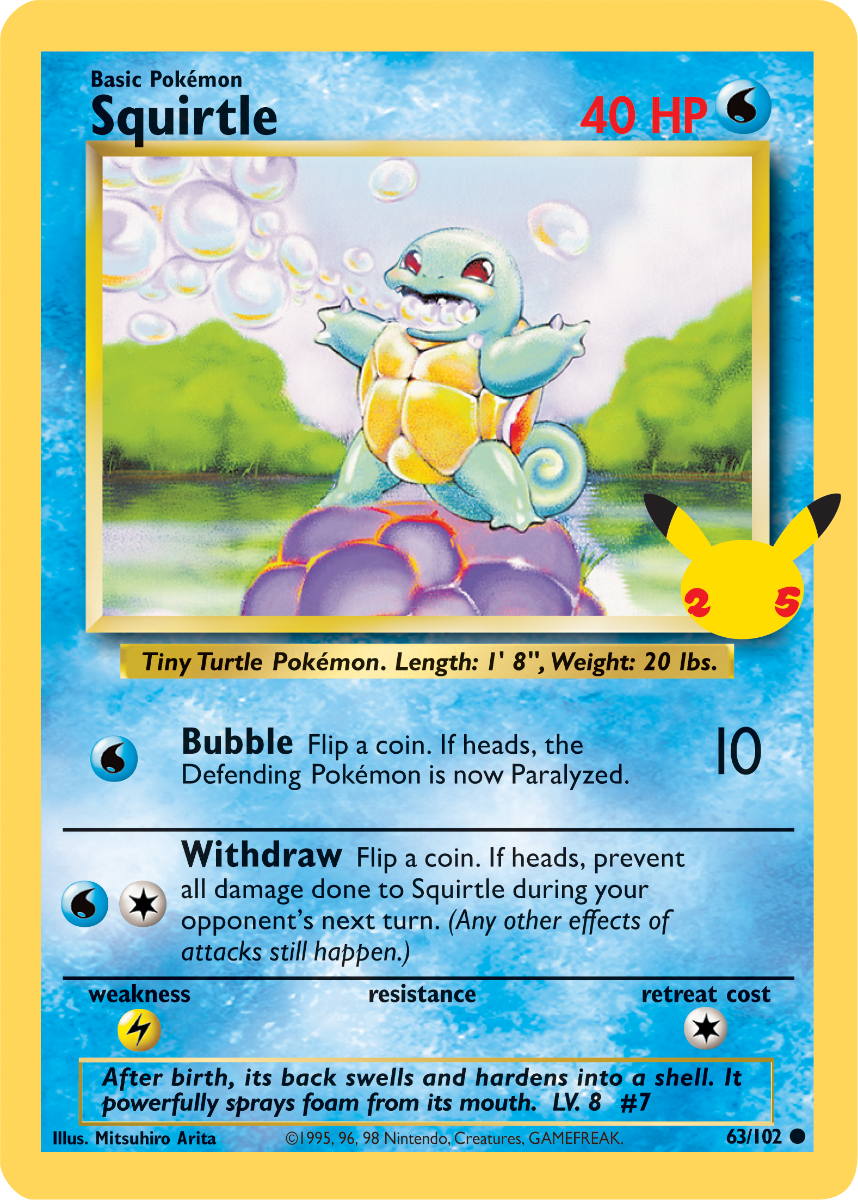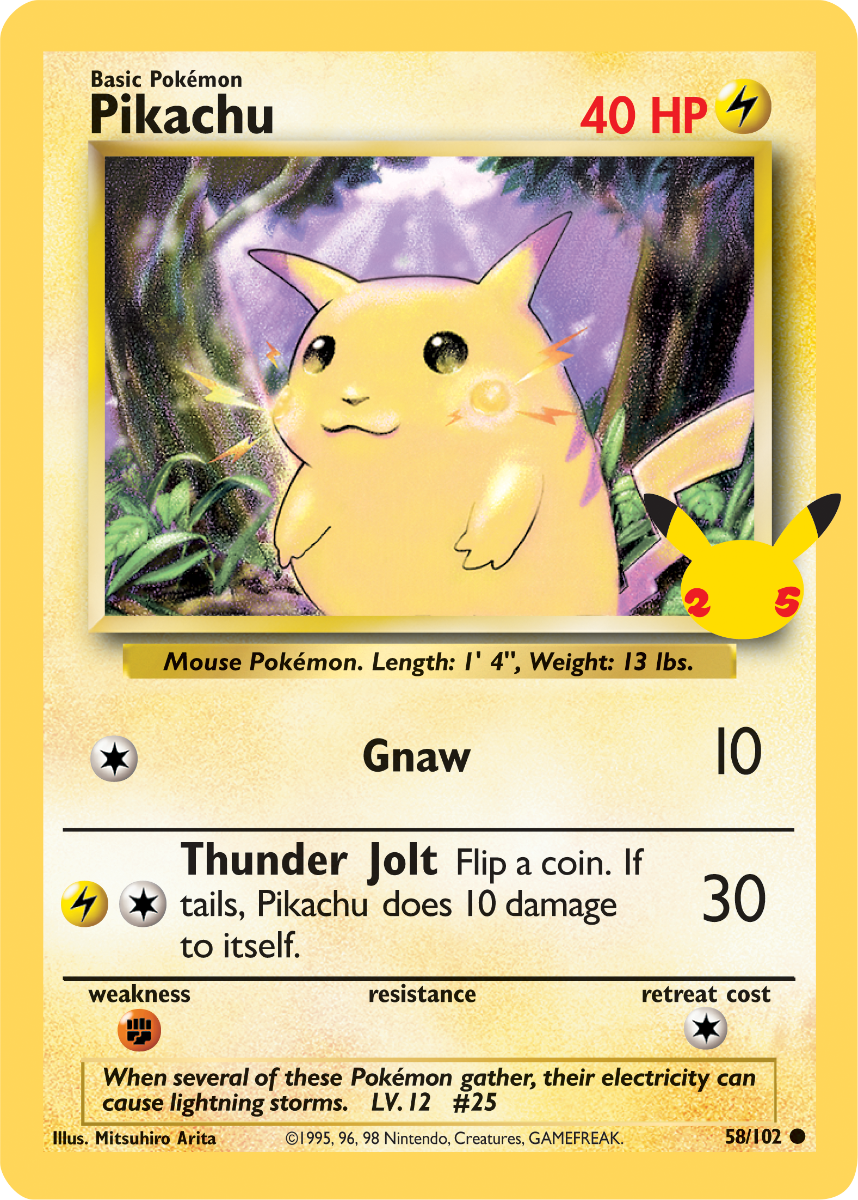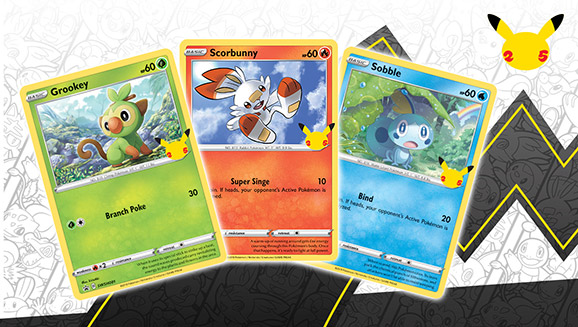
You always remember your first, don’t you?
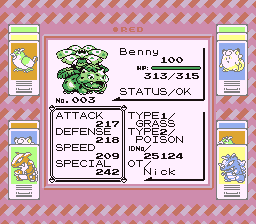
…first starter Pokémon. We’re talking about Pokémon here. I remember my first starter Pokémon; I was still in high school when Pokémon Red & Blue came out, I didn’t have a fancy Game Boy like everyone else did, so I had to emulate it. I ended up choosing a Bulbasaur, which I named Benny! I don’t remember why I called it “Benny”, but I’m up to “Benny the Fourth” in my Pokémon Shield game. I even still have Benny! Ah, good times…
Anyways, TPCI wanted to celebrate this moment and memory with everyone during their “Pokémon 25” anniversary celebrations in 2021, and so they released a monthly jumbo pack series called “First Partner Pack”. While each of the First Partner Packs will have a specific focus on the Starters in each Generation (up to Gen 8), their overall scope was the same. These shared details include:
- Each First Partner Pack focuses on each Gen, with eight packs released in total.
- Each pack was released once per month, starting with the Galar (Gen 8) Starters in March 2021 and working its way backwards to the Kanto (Gen 1) Starters in October 2021.
- Each pack themselves will contain three oversized game cards—one for each Basic Starter—and two standard 10-card boosters packs from the then recent sets.
- Fortunately all three oversized cards were made available in the same pack, so you didn’t have to buy multiple packs in order to try to get all three (so no one bought three and only got nothing but Grookeys)
- As for the two booster packs included, I wasn’t sure if they’re limited to packs from a specific set, or if they’re randomly added from any then-recent set. For example, my packs were from SwSh Vivid Voltage and… Sun & Moon(???)
- The oversized card is a bit over 4x the size of a normal card… as in, twice the width and twice the height; you can see an example of the size at the bottom of this article.
- The cards themselves are sourced directly from their original printings, and are basically completely and 100% unedited apart from the added the “Pokémon 25” logo stamped in the lower-right corner of the Pokémon’s artwork. (There are SOME minor exceptions to this; see the “Minor changes” section below)
- The MSRP cost for each First Partner Pack in 2021 was US$9.99.
- It was also released in Europe for €20 as well as in Latin America (tho Spanish speakers got the English version). Apparently the European versions had the cards individually sleeved? Oddly enough I’m getting inconsistant info about this.
- French (Des Packs Premiers Partenaires)
- German (Erste Partner Pack)
- Italian (Buste Compagni D’Avventura)
- Portugese-Brazil
…that’s pretty much it. Three big cards, two booster packs. If you want to see the packs being opened, just watch this handy video:
Neat stuff, huh?
Pictures and Release Info
I made sure to get every First Partner Pack that was released… and here it is! This is the first First Partner Pack covering the Galar starters; you can see what the pack looked like as well as how big the jumbo cards were relative to normal cards (in this case, McDonalds promos, which also have the Pokémon 25 logo on it):
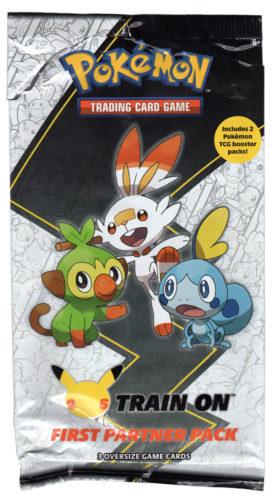
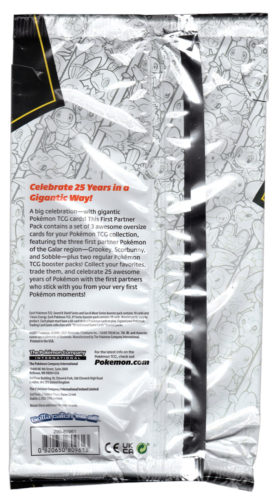
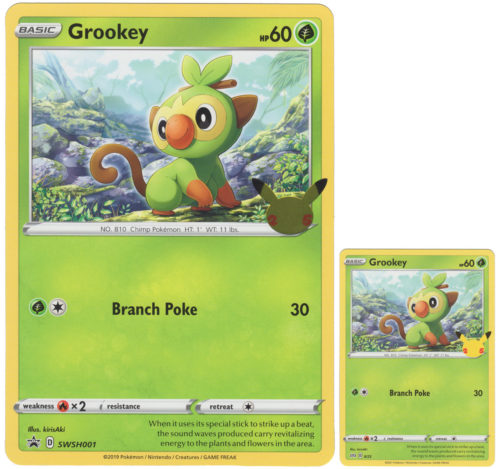
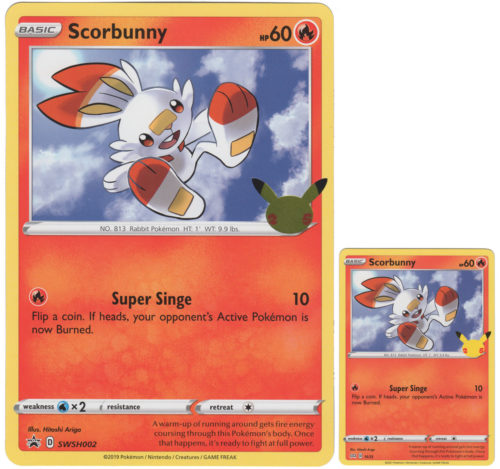
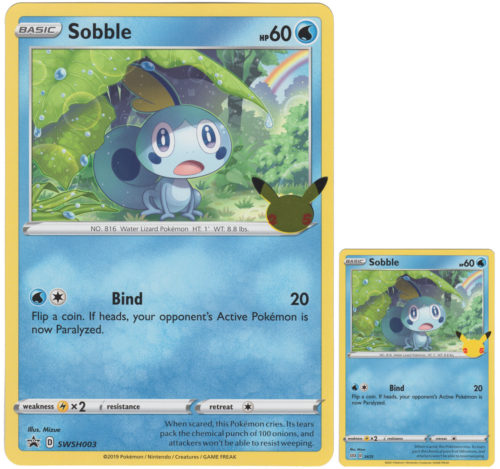
The very first item released in the First Partner Pack campaign was a jumbo card binder—the “First Partner Collector’s Binder”—with enough sleeves to store all 24 Starter Pokémon cards PLUS an exclusive jumbo Base Set Pikachu card that came with the binder. Also included was a handy guide about the First Partner Pack line plus a handy checklist. Take a look!
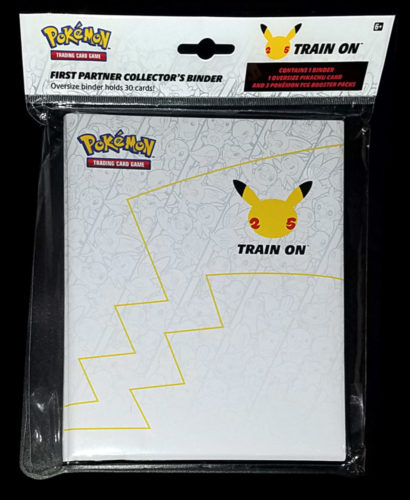
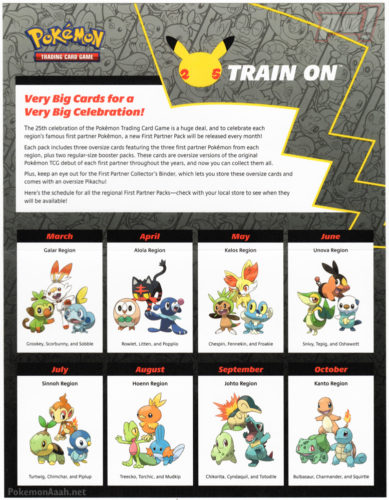
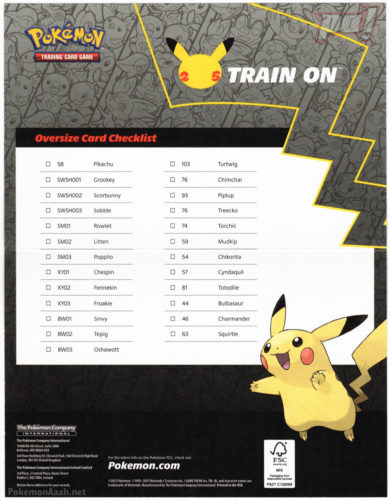
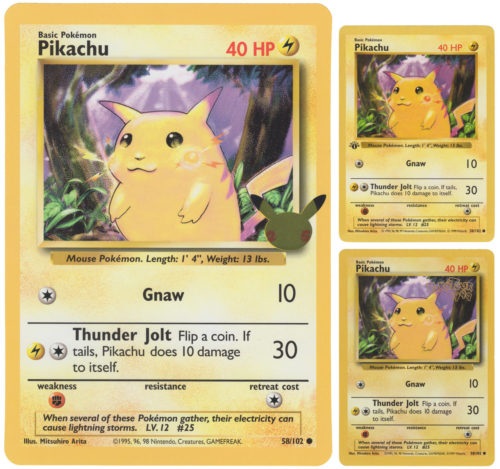
The checklist on the included card shows the full list of the packs and which oversized cards will be in it, as well as when they were released. Here’s a handy checklist with links to more info about each card:
| GEN | RELEASE DATE | STARTERS | ||
| Collector Binder | February 26, 2021 | ZL Pikachu | ||
| 8 — Galar | March 5, 2021 | ZG Grookey | ZR Scorbunny | ZW Sobble |
| 7 — Alola | April 2, 2021 | ZG Rowlet | ZR Litten | ZW Popplio |
| 6 — Kalos | May 7, 2021 | ZG Chespin | ZR Fennekin | ZW Froakie |
| 5 — Unova | June 4, 2021 | ZG Snivy | ZR Tepig | ZW Oshawott |
| 4 — Sinnoh | July 9, 2021 | ZG Turtwig | ZR Chimchar | ZW Piplup |
| 3 — Hoenn | August 6, 2021 | ZG Treecko | ZR Torchic | ZW Mudkip |
| 2 — Johto | September 3, 2021 | ZG Chikorita | ZR Cyndaquil | ZW Totodile |
| 1 — Kanto | October 8, 2021 | ZG Bulbasaur | ZR Charmander | ZW Squirtle |
Finally, Nintendo had also released high quality art assets for both the First Partner Pack packs and every card included in the set. Check it out! (BTW, if you want to make your own First Partner Pack, check out this post with a blank!)
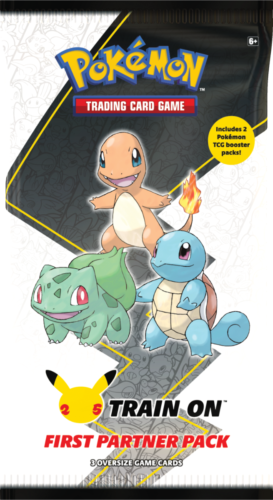
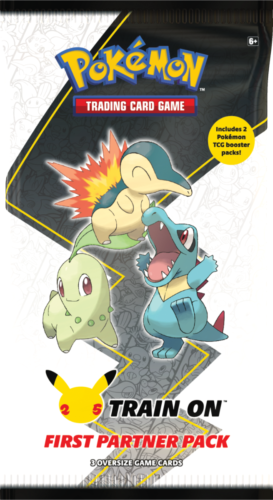
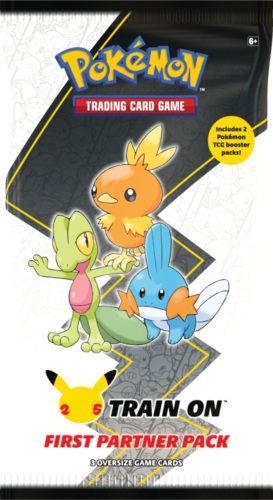
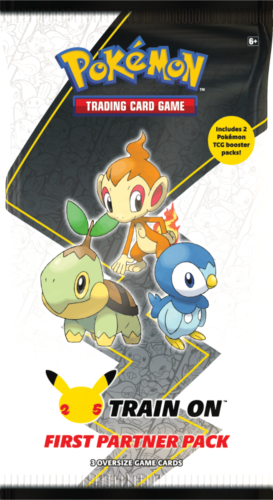
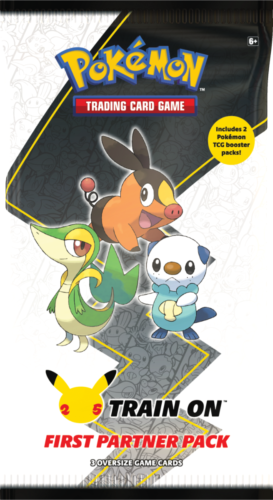
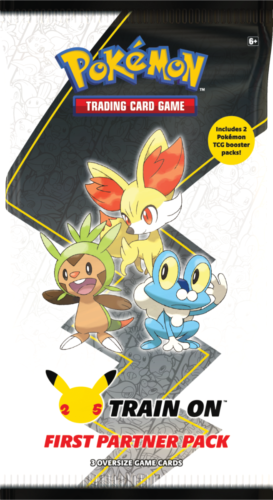
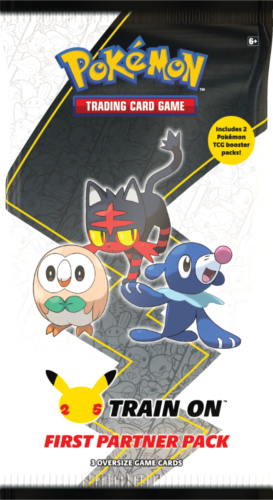
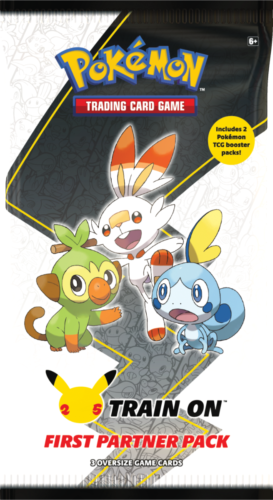
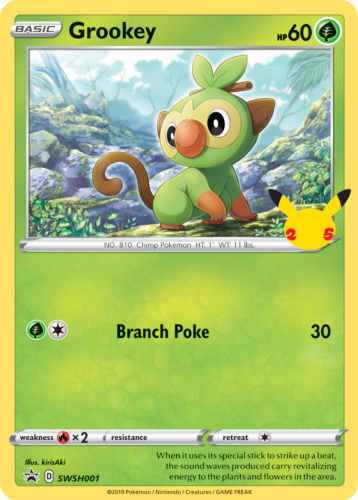
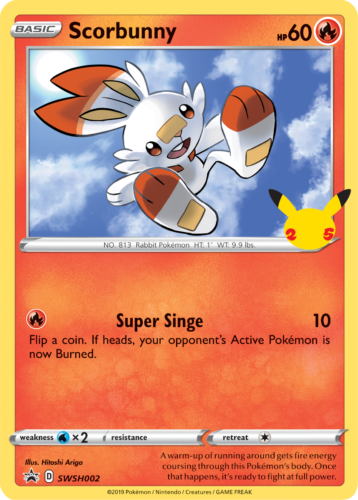
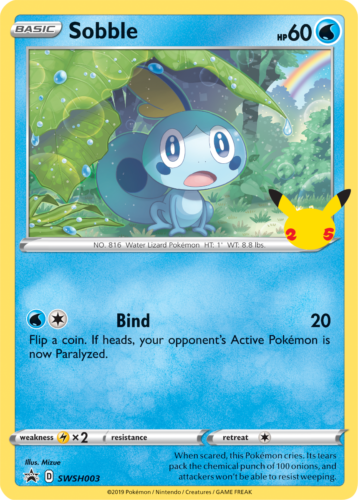
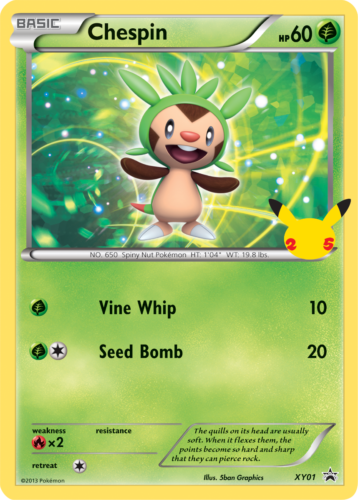
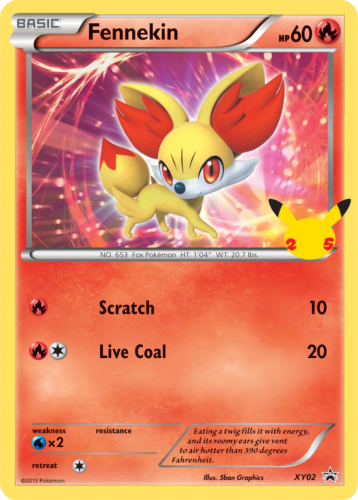
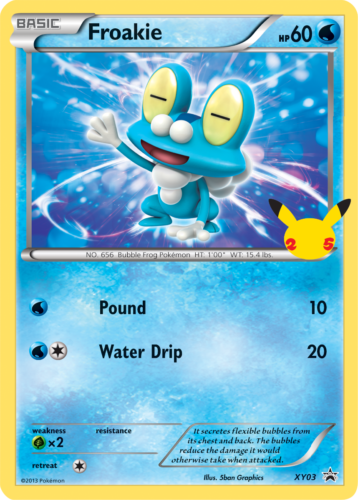
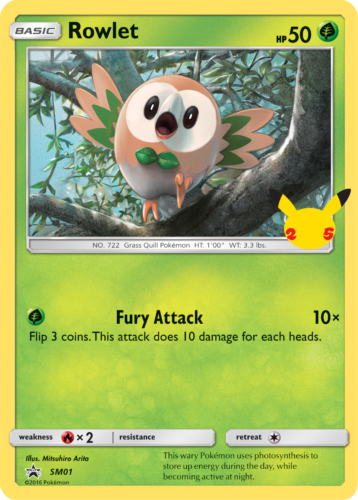
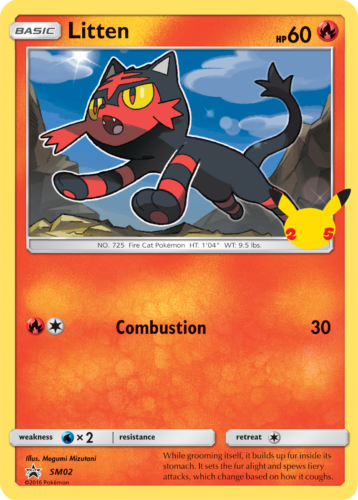
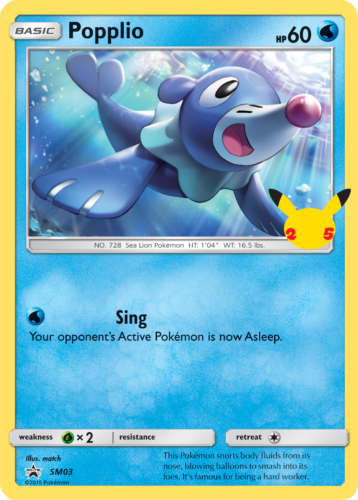
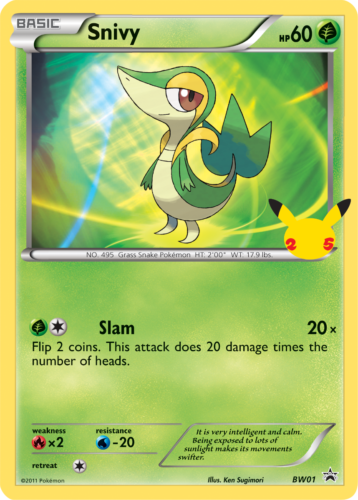
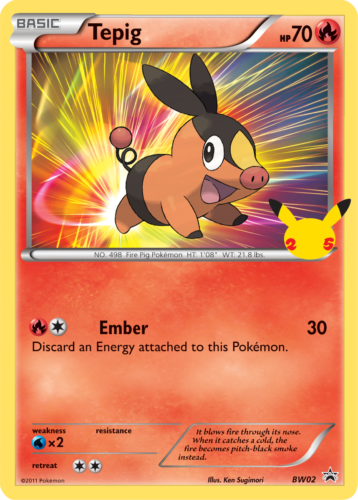
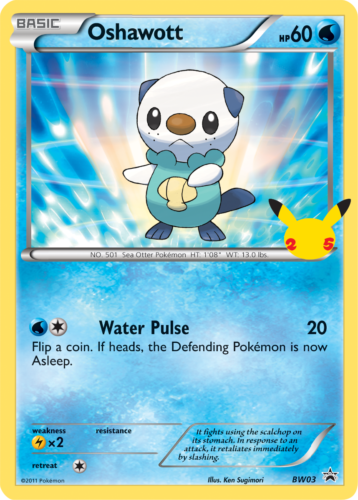
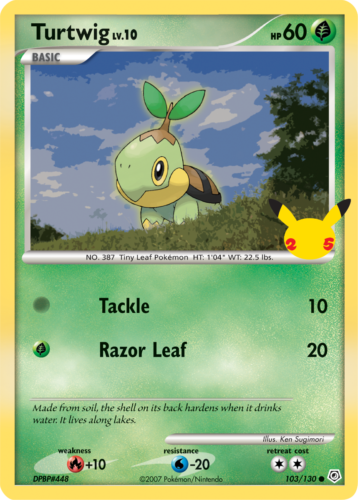
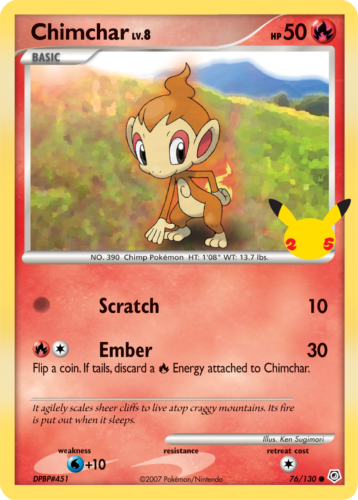
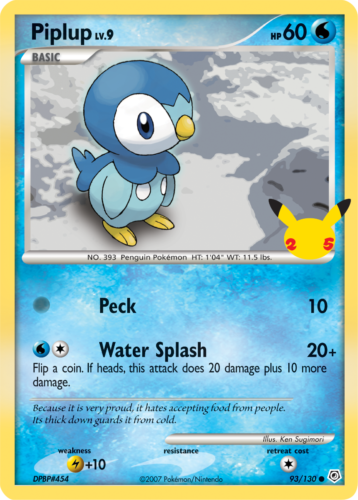
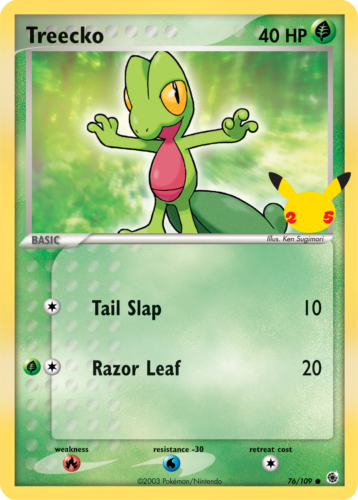
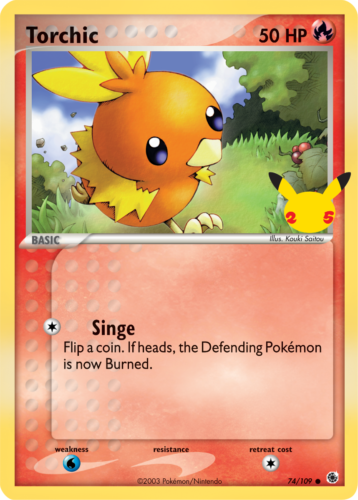
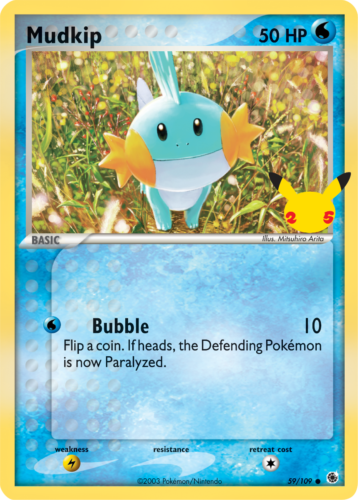
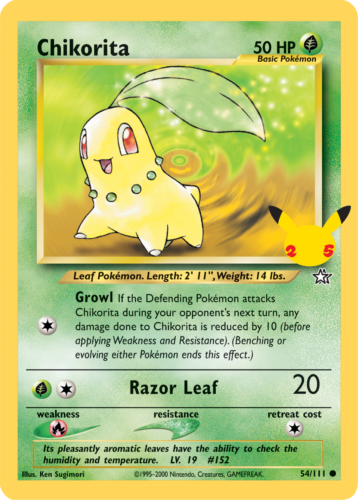
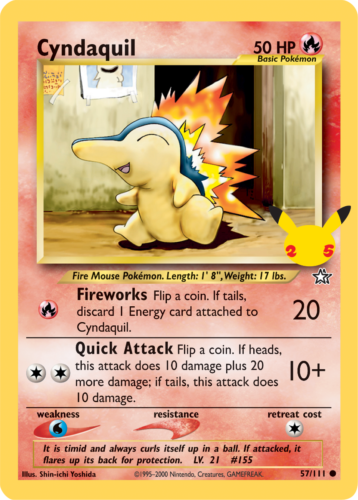
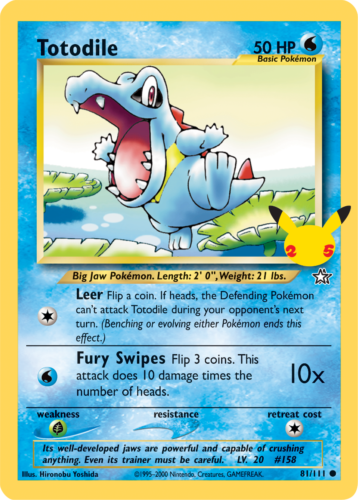
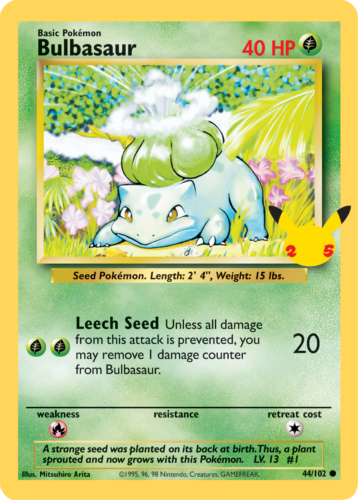
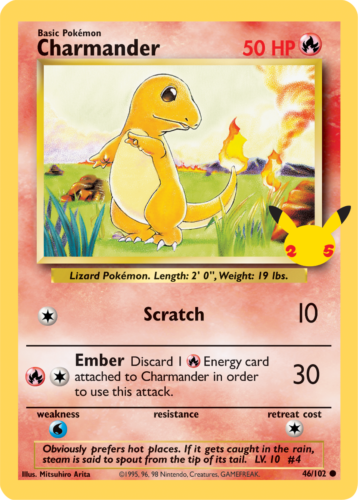
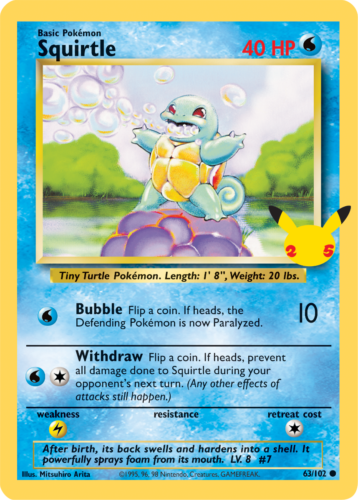
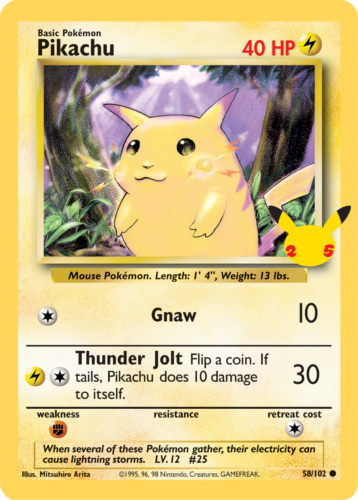
Minor Changes
Generally the oversized cards are sourced directly from their original card files, with basically no edits made to them apart from addings the “Pokémon 25” logo on them. However, for the cards sourced from Wizards and early-Nintendo cards, there were some minor differences. Take a look and see if you can see what my SPECHUL EYES saw.
First, Bulbasaur (representing a typical Wizards-era card):
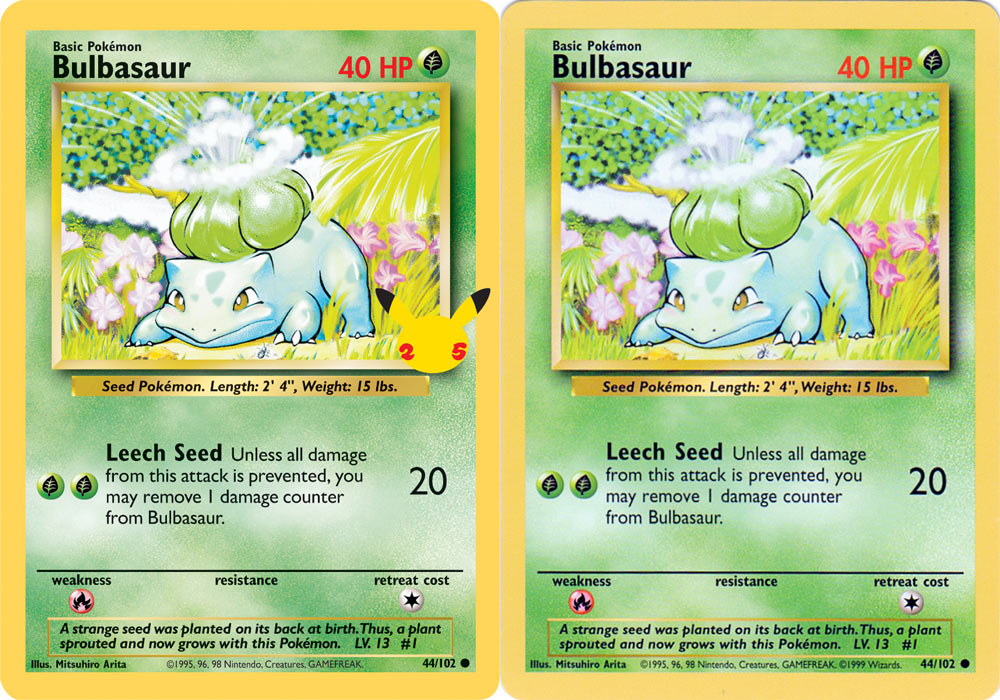
And now Mudkip (representing an early-Nintendo card):
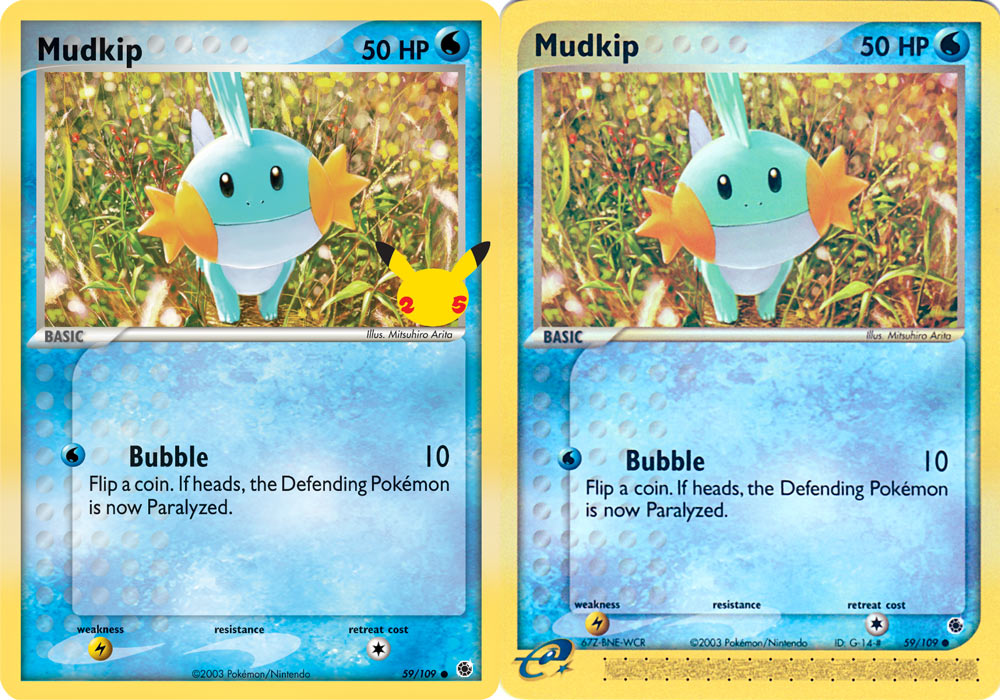
See it? Yes? No? Maybe so? Here, I’ll just zoom in here:

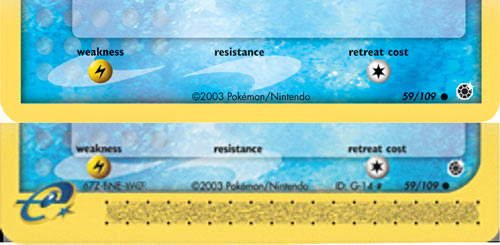
Yep, for the Wizards-era cards, the “© 1999 Wizards” copyright was removed, while the early-Nintendo cards had the Card-E portions removed. So these AREN’T the exact same cards as the ones I grew up with. I want my money back! (…well somebody better give me some money!)
Joking aside, clearly there were good reasons for these changes.
Wizards-era Cards
As I’m sure you’ve noticed, Wizards of the Coast no longer has anything to do with the Pokémon TCG. As a reminder, they had the international TCG license from 1999 to 2003, and they stamped their name on Base-Gym era cards, which I pointed out above on the Bulbasaur card. By the time Neo Genesis came out in 2000, they decided to remove their copyright from the card text, which you can see below:

LEFT: “Pokémon 25” Version — RIGHT: Original Neo Genesis Release Version
Either way, Wizards did their bit for King & Country, and since they’re out of the picture, Nintendo doesn’t need to include their names on any new reprints. Though curiously enough, they have kept Wizards’ name on social media posts using Wizards-era cards:
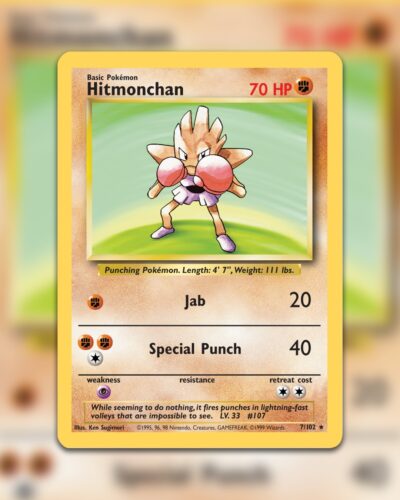
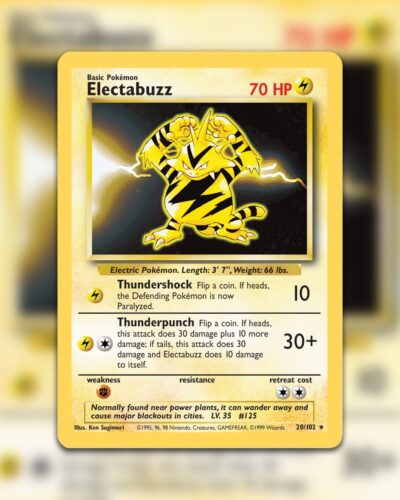
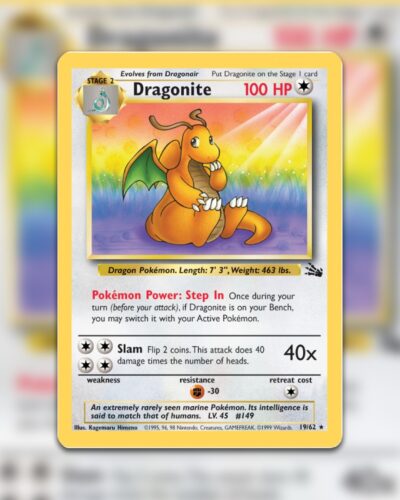
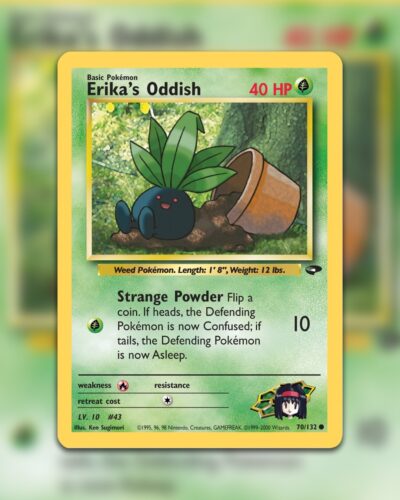
One side note about the Wizards-era card designs: it’s interesting how layout software handles old files. My SPECHUL EYES noticed slight differences in kerning and spacing between the original 1999 prints and the 2021 reprints. It’s a clear indication that Nintendo used Wizards’ original design files—handed over when the license changed in 2003—and so they just opened the original “Base Set – Bulbasaur.indd” file, removed the ©1999 Wizards line, and added the 25th anniversary stamp. But reopening a 20+ year-old file in a modern version of InDesign likely introduced small formatting changes. Even font files like Gill Sans may have shifted slightly over time, which could explain the kerning differences.
Here’s just a quick example of what I mean: the left image has the letters “d”, “l” and “p” aligned, while the right image has the background aligned… and you can see the difference in how the text was rendered between 1999 and 2021. If anything, this is just a fun look behind the scenes of card design and how things change as technology moves on.
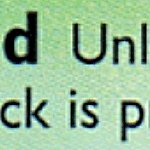
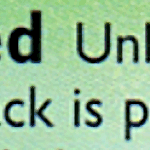
Hoenn & the e-Reader
The other major change in card designs were the removal of the “Card-E” portions on the Hoenn starters, almost as if the cards were designed using the card blanks seen just before the release of Diamond & Pearl in the TCG. Now the reasons for this is actually somewhat similar to the removal of ©1999 Wizards from the Kanto starters: the Dot Code bar was licensed from Olympus, and since that deal was done and over with, so it’s time to remove it.
But the weird part is… they also removed the 9-character code (represented by Mudkip’s 67Z-BNE-6MF code) from each Hoenn starter, even tho it was unrelated to the Card-E feature. Here’s some reverse holos from the time with the 9-character code but no code:
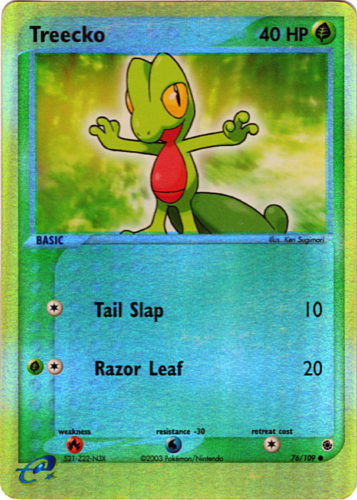
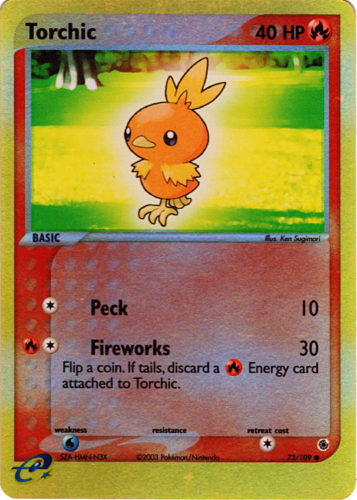
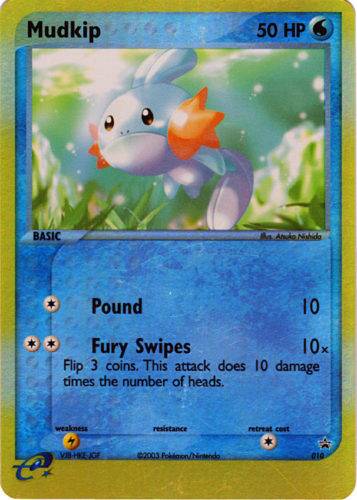
On the other hand, many of the Nintendo Card-e cards were reprinted in a code-less form, in sets like EX Battle Stadium. Take a look!

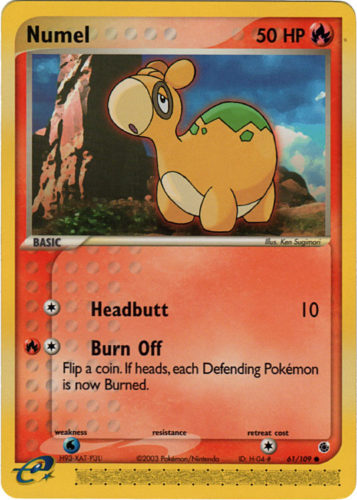
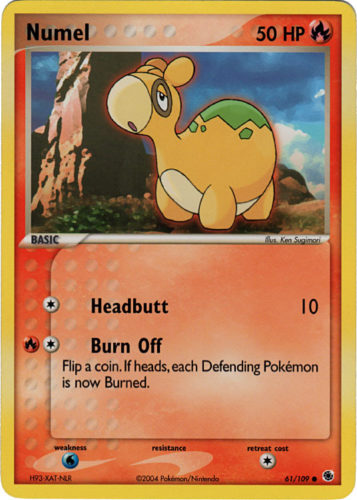
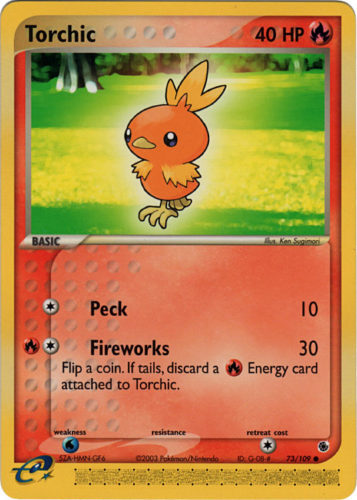
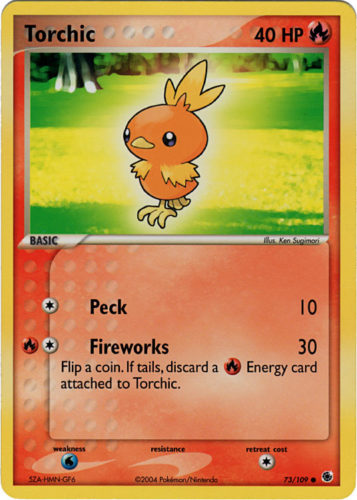
But here’s the thing… I can’t seem to find a version of the Mudkip and Treecko cards in English without the Card-e bar like with the Torchic above. The closest I found where some non-English promo cards. So it draws into question about where exactly these cards were sourced from: did they make new Card-e bar-less cards for the jumbo cards, or did they take those non-English promo cards and convert them into English? ORRRRR maybe they always had those Card-E bar-less cards made up in but they were never used? Like maybe the raw card file allows for quick conversion between the two? Either way, I guess since they never existed in this form in English, instead of trying to figure out what new 9-character code to give them, it was easier to just blank them out.
Those are some HUUUGE cards!
To get an idea of how HUUUGEE the oversized cards are, I ran the numbers for you:
- Technically the cards are just about 4.41x the size of a normal card… as in, 2.1x wide and 2.1x high. I measured the oversized cards to be 5.25″ × 7.35″ in freedom units, or 133.35 mm × 186.69 mm; consider that normal cards are 2.5″ × 3.5″ (or 63.5 × 88.9 mm).
- Despite being bigger, the oversized cards seem a smidge more flimsier. And no, it’s not because it’s just bigger and therefore relatively thinner… it’s actually about 5% thinner than normal cards. For example, normal cards are intended to be 0.301 mm thick but these cards are about 0.282 mm thick.
Here’s an example scan of the Pikachu you get from the pack with a couple other Pikachu cards I had:
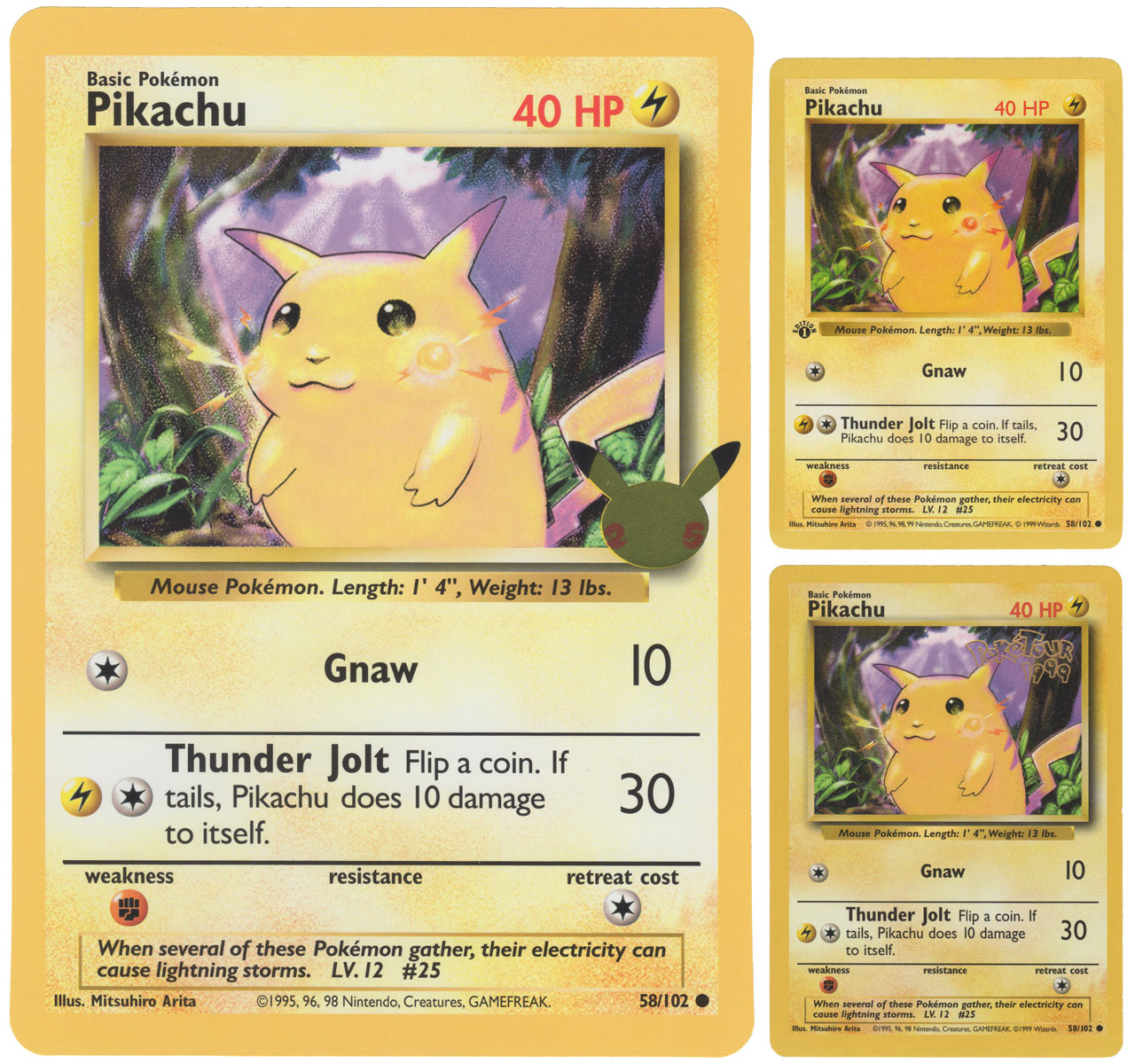
Now what’s kinda interesting about these oversized cards is that they give us a sort of window into the size that these cards are made in. For example, if you zoom in a bit on the Jumbo Pikachu card, you can actually see some pixelation of the original digital files they used to make these cards:
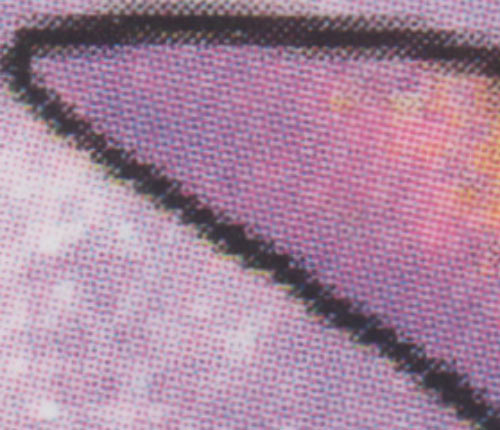
Long story short, by counting the pixels, I was able to determine that these cards were probably designed at around 140 dpi, or a working pixel dimension of about 733 × 1033 pixels (give or take)… which, not coincidentally, is about the size of Pokémon TCG Live card assets, implying that PTCGL cards are exported directly from the raw design files as well. Tho I suspect that they’re up to 300-600 dpi nowadays.
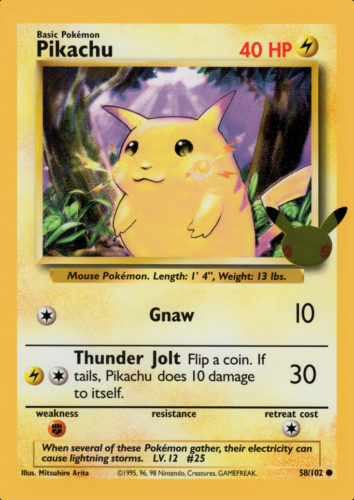
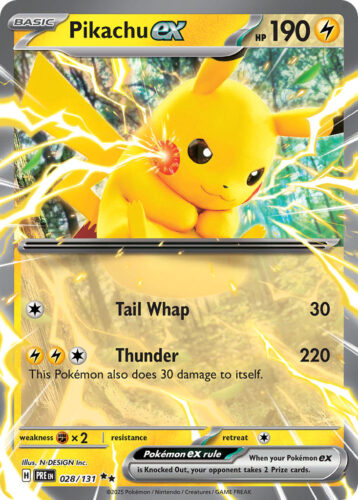
Pikachu ex sources from PkmnCards.com – used with permission!
Pretty neat, huh?

